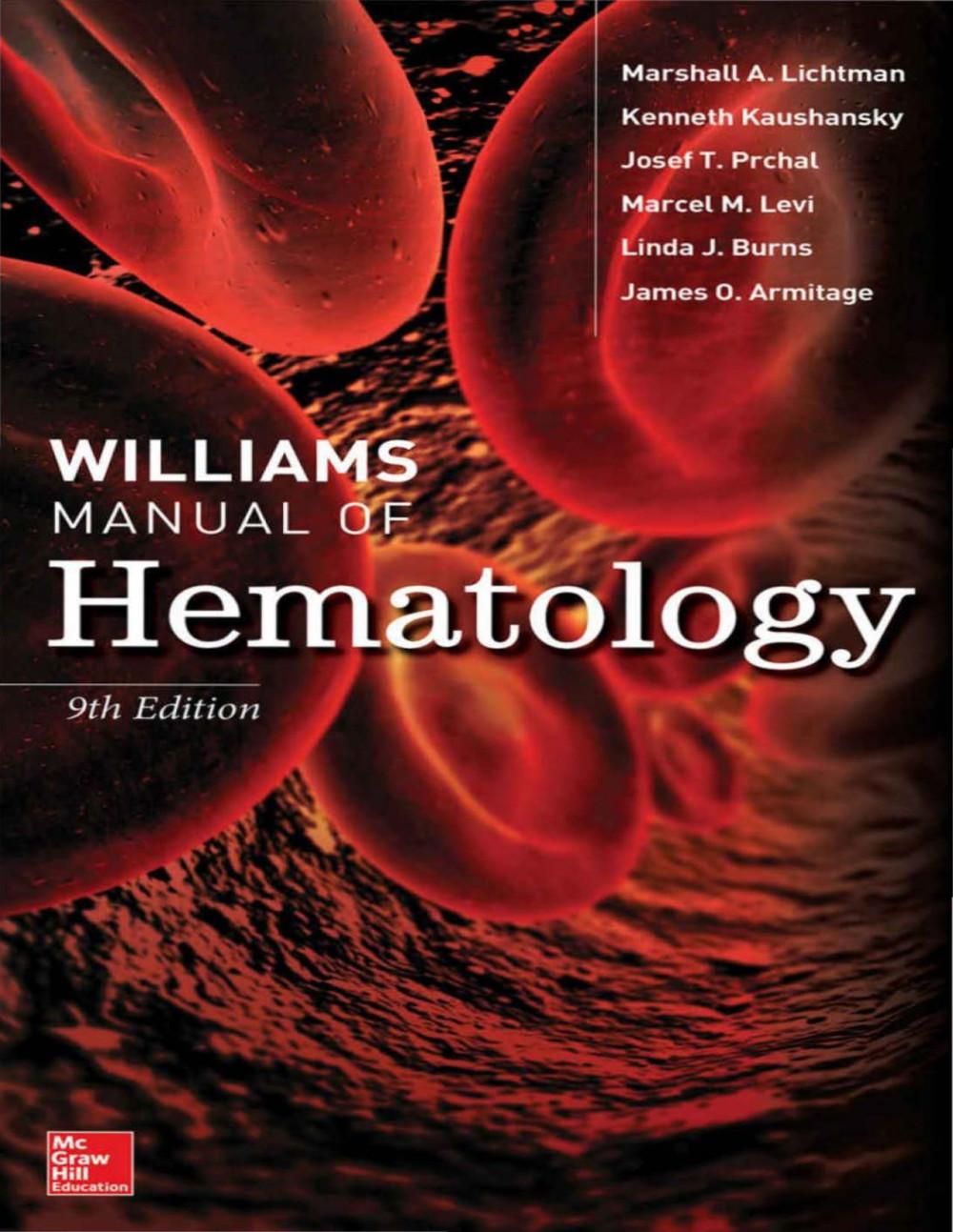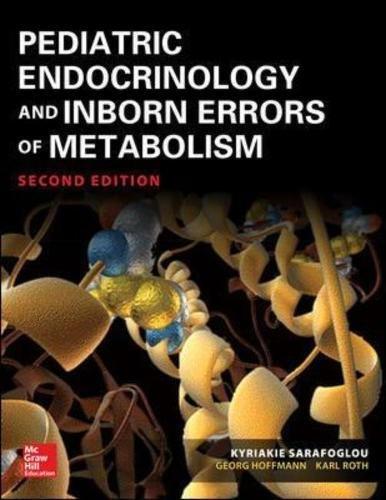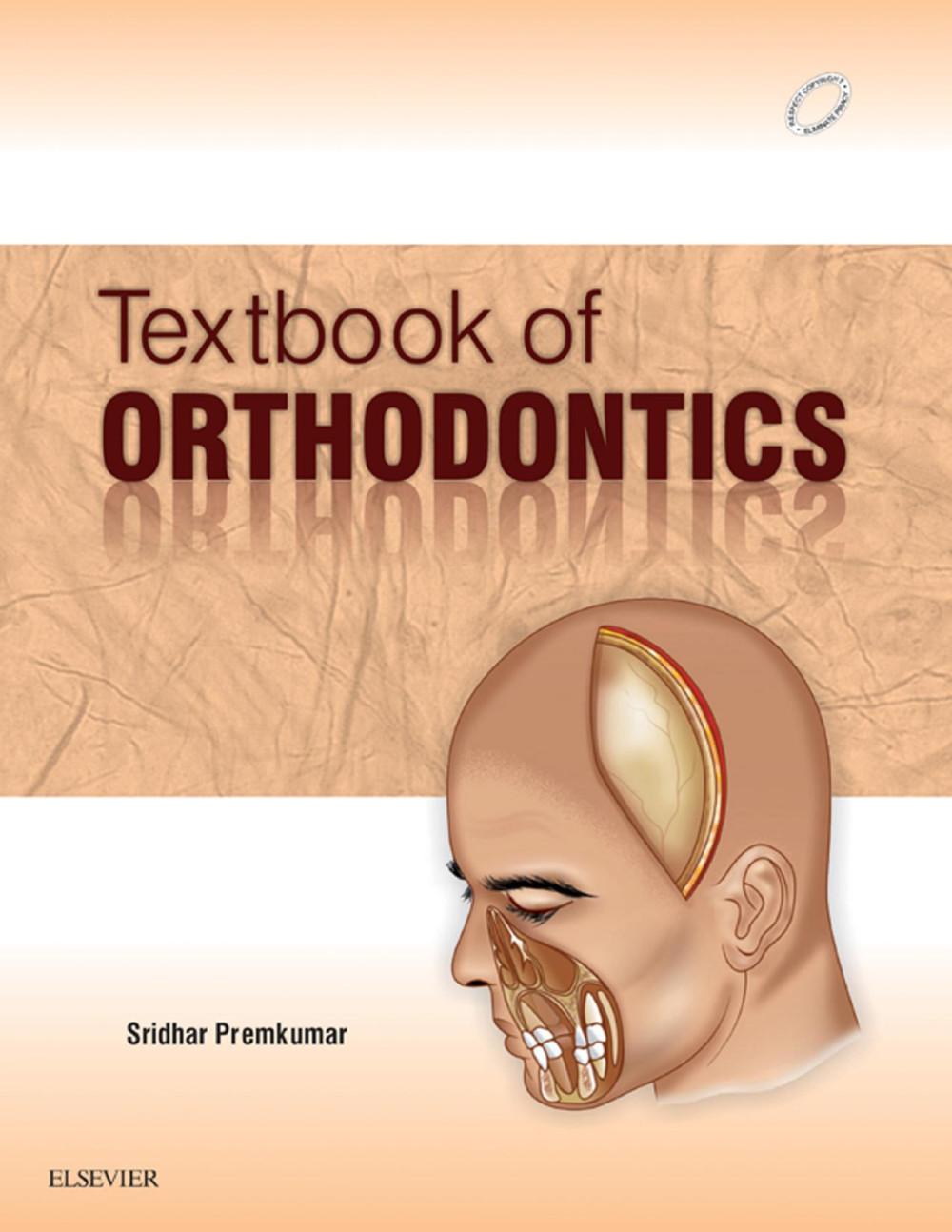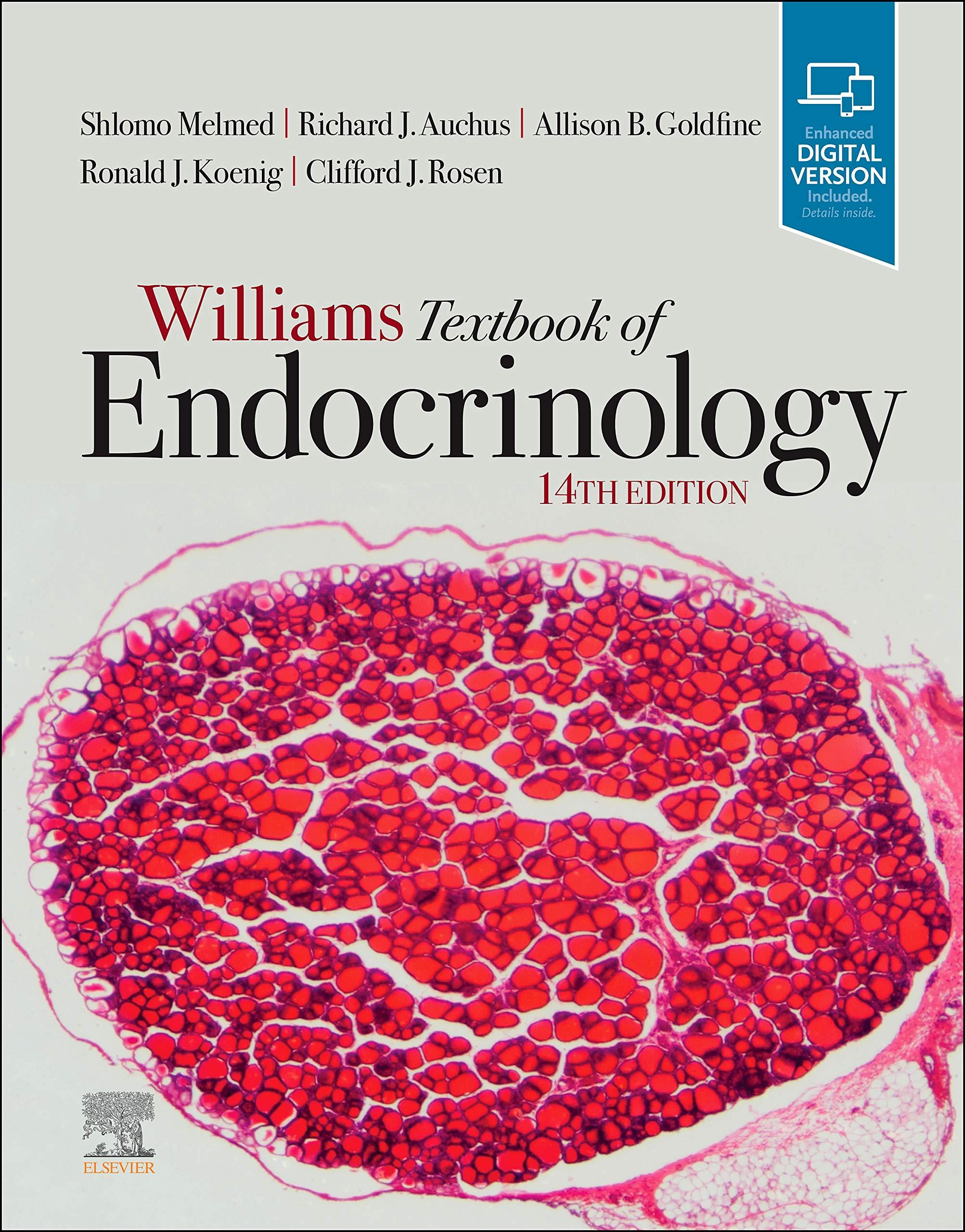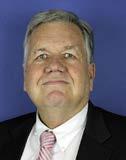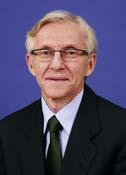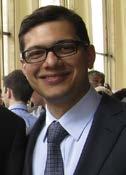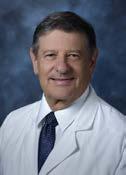Williams Textbook of Endocrinology
14TH EDITION
Shlomo Melmed, MB ChB, MACP
Executive Vice President and Dean of the Medical Faculty
Cedars-Sinai Medical Center
Los Angeles, California
Richard J. Auchus, MD, PhD
Professor
Departments of Pharmacology and Internal Medicine
Division of Metabolism, Endocrinology, and Diabetes University of Michigan
Endocrinology Service Chief
Ann Arbor VA Healthcare System
Ann Arbor, Michigan
Allison B. Goldfine, MD
Associate Physician, Division of Endocrinology, Diabetes, and Hypertension
Brigham and Women’s Hospital
Lecturer, Part-Time
Harvard Medical School
Boston, Massachusetts
Director, Translational Medicine Cardiometabolic Disease
Novartis Institute of Biomedical Research
Cambridge, Massachusetts
Ronald J. Koenig, MD, PhD
Professor
Department of Internal Medicine
Division of Metabolism, Endocrinology, and Diabetes University of Michigan
Ann Arbor, Michigan
Clifford J. Rosen, MD
Professor of Medicine
Tufts University School of Medicine Boston, Massachusetts
Elsevier
1600 John F. Kennedy Blvd.
Ste 1800 Philadelphia, PA 19103-2899
WILLIAMS TEXTBOOK OF ENDOCRINOLOGY, FOURTEENTH EDITION
Copyright © 2020 by Elsevier, Inc. All rights reserved.
ISBN: 978-0-323-55596-8
No part of this publication may be reproduced or transmitted in any form or by any means, electronic or mechanical, including photocopying, recording, or any information storage and retrieval system, without permission in writing from the publisher. Details on how to seek permission, further information about the Publisher’s permissions policies and our arrangements with organizations such as the Copyright Clearance Center and the Copyright Licensing Agency, can be found at our website: www.elsevier.com/permissions.
This book and the individual contributions contained in it are protected under copyright by the Publisher (other than as may be noted herein).
Notice
Practitioners and researchers must always rely on their own experience and knowledge in evaluating and using any information, methods, compounds or experiments described herein. Because of rapid advances in the medical sciences, in particular, independent verification of diagnoses and drug dosages should be made. To the fullest extent of the law, no responsibility is assumed by Elsevier, authors, editors or contributors for any injury and/or damage to persons or property as a matter of products liability, negligence or otherwise, or from any use or operation of any methods, products, instructions, or ideas contained in the material herein.
Previous editions copyrighted 2016 by Elsevier Inc. and 2011, 2008, 2003, 1998, 1992, 1985, 1981, 1974, 1968, 1962, 1955, 1950 by Saunders, an affiliate of Elsevier Inc.
Copyright renewed 1990 by A.B. Williams, R.I. Williams
Copyright renewed 1983 by William H. Daughaday
Copyright renewed 1978 by Robert H. Williams
Library of Congress Control Number: 2019952358
Senior Content Strategist: Nancy Duffy
Senior Content Development Specialist: Rae Robertson
Publishing Services Manager: Catherine Jackson
Senior Project Manager: Claire Kramer
Design Direction: Amy Buxton
Printed in Canada
Last digit is the print number: 9 8 7 6 5 4 3 2 1
Sarah L. Berga, MD
Professor and Director
Division of Reproductive Endocrinology and Infertility
University of Utah School of Medicine
Salt Lake City, Utah
Sanjay K. Bhadada, MBBS, MD, DM
Professor Department of Endocrinology
Nehru Hospital
Post Graduate Institute of Medical Education and Research
Chandigarh, India
Arti Bhan, MD
Division Head, Endocrinology, Diabetes, Bone and Mineral Disorders
Henry Ford Health System
Detroit, Michigan
Shalender Bhasin, MB, BS
Professor of Medicine
Harvard Medical School
Director, Research Program in Men’s Health: Aging and Metabolism
Director, Boston Claude D. Pepper Older Americans Independence Center
Brigham and Women’s Hospital
Boston, Massachusetts
Dennis M. Black, PhD
Department of Epidemiology and Biostatistics
University of California, San Francisco
San Francisco, California
Annabelle Brennan, MBBS, LLB (Hons)
Department of Obstetrics and Gynaecology
Royal Women’s Hospital
Melbourne, Australia
Andrew J.M. Boulton, MD, FACP, FRCP
Professor
Centre for Endocrinology and Diabetes
University of Manchester
Manchester, Great Britain
Visiting Professor
Division of Endocrinology, Metabolism, and Diabetes
University of Miami
Miami, Florida
Glenn D. Braunstein, MD
Professor of Medicine
Cedars-Sinai Medical Center
Professor of Medicine Emeritus
The David Geffen School of Medicine at University of California, Los Angeles
Los Angeles, California
Gregory A. Brent, MD
Professor of Medicine and Physiology
Chief, Division of Endocrinology, Diabetes, and Metabolism
The David Geffen School of Medicine at University of California, Los Angeles Los Angeles, California
F. Richard Bringhurst, MD
Physician and Associate Professor of Medicine
Endocrine Unit
Massachusetts General Hospital
Harvard Medical School
Boston, Massachusetts
Juan P. Brito, MD, MS
Associate Professor
Department of Medicine
Division of Endocrinology
Knowledge and Evaluation Research Unit in Endocrinology
Mayo Clinic Rochester, Minnesota
Todd T. Brown, MD, PhD
Professor of Medicine and Epidemiology
Division of Endocrinology, Diabetes, and Metabolism
Johns Hopkins University Baltimore, Maryland
Michael Brownlee, MD
Anita and Jack Saltz Chair in Diabetes Research Emeritus
Professor Emeritus, Medicine and Pathology
Associate Director for Biomedical Sciences
Emeritus
Einstein Diabetes Research Center
Albert Einstein College of Medicine
Bronx, New York
Serdar E. Bulun, MD
JJ Sciarra Professor of Obstetrics and Gynecology and Chair
Department of Obstetrics and Gynecology
Northwestern University Feinberg School of Medicine
Chicago, Illinois
David A. Bushinsky, MD
Professor of Medicine and of Pharmacology and Physiology
Department of Medicine
University of Rochester School of Medicine
Rochester, New York
Christin Carter-Su, ScB, PhD
The Anita H. Payne Distinguished University Professor of Physiology
The Henry Sewall Collegiate Professor of Physiology
Professor of Molecular and Integrative Physiology
Professor of Internal Medicine
University of Michigan Medical School
Associate Director
Michigan Diabetes Research Center
Ann Arbor, Michigan
Yee-Ming Chan, MD, PhD
Associate Physician
Department of Pediatrics
Division of Endocrinology
Boston Children’s Hospital
Assistant Professor of Pediatrics
Harvard Medical School
Boston, Massachusetts
Ronald Cohen, MD
Associate Professor
Department of Medicine
University of Chicago
Chicago, Illinois
David W. Cooke, MD
Associate Professor
Department of Pediatrics
Johns Hopkins University School of Medicine
Baltimore, Maryland
Philip E. Cryer, MD
Professor of Medicine Emeritus
Department of Medicine
Washington University School of Medicine
Physician
Barnes-Jewish Hospital
St. Louis, Missouri
Eyal Dassau, PhD
Director, Biomedical Systems Engineering Research Group
Senior Research Fellow in Biomedical Engineering in the Harvard John A. Paulson School of Engineering and Applied Sciences
Harvard University
Cambridge, Massachusetts
Mehul T. Dattani, MD, MBBS, DCH, FRCPCH, FRCP
Professor
Department of Paediatric Endocrinology
Great Ormond Street Hospital for Children
NHS Foundation Trust
Genetics and Genomic Medicine Programme
University College London Institute of Child Health
London, Great Britain
Mark E. Cooper, AO, MB BS, PhD, FRACP
Professor and Head
Department of Diabetes
Central Clinical School
Monash University
Melbourne, Australia
Ewerton Cousin, MSc
Postgraduate Program in Epidemiology
Universidade Federal do Rio Grande do Sul
Porto Alegre, Brazil
Francisco J.A. de Paula, MD, PhD
Associate Professor of Endocrinology and Metabolism
Department of Internal Medicine
Ribeirão Preto Medical School
University of São Paulo
Ribeirao Preto, Brazil
Marie B. Demay, MD
Physician and Professor of Medicine
Endocrine Unit
Massachusetts General Hospital
Harvard Medical School
Boston, Massachusetts
Sara A. DiVall, MD
Associate Professor
Departments of Pediatrics
Division of Endocrinology
University of Washington
Seattle, Washington
Bruce B. Duncan, MD, MPH, PhD
Department of Social Medicine and Postgraduate Program in Epidemiology
School of Medicine
Universidade Federal do Rio Grande do Sul
Porto Alegre, Brazil
Eva L. Feldman, MD, PhD
Russell N. DeJong Professor of Neurology
Director, Program for Neurology Research and Discovery
University of Michigan Medical School
Ann Arbor, Michigan
Ele Ferrannini, MD
Professor of Medicine
Institute of Clinical Physiology
National Research Council Pisa, Italy
Heather A. Ferris, MD, PhD
Assistant Professor of Medicine
University of Virginia Charlottesville, Virginia
Sebastiano Filetti, MD
Full Professor of Internal Medicine
Department of Translational and Precision Medicine
Sapienza University of Rome Rome, Italy
Laercio J. Franco, MD, MPH, PhD
Professor of Social Medicine
Ribeirão Preto Medical School–University of São Paulo
Ribeirão Preto, Brazil
Ezio Ghigo, MD
Professor of Endocrinology
Division of Endocrinology, Diabetology, and Metabolism
University of Turin
Turin, Italy
Ira J. Goldberg, MD
Clarissa and Edgar Bronfman Jr. Professor
New York University School of Medicine
Director, Division of Endocrinology, Diabetes, and Metabolism
New York University Langone Health
New York, New York
Allison B. Goldfine, MD
Associate Physician, Division of Endocrinology, Diabetes, and Hypertension
Brigham and Women’s Hospital
Lecturer, Part-Time
Harvard Medical School
Boston, Massachusetts
Director, Translational Medicine
Cardiometabolic Disease
Novartis Institute of Biomedical Research
Cambridge, Massachusetts
Evelien F. Gevers, MD, PhD
Department of Pediatric Endocrinology
Royal London Children’s Hospital
Barts Health NHS Trust Centre for Endocrinology
William Harvey Research Institute
Queen Mary University of London London, Great Britian
Peter A. Gottlieb, MD
Professor Department of Pediatrics University of Colorado
Aurora, Colorado
Steven K. Grinspoon, MD
Professor of Medicine
Harvard Medical School
Chief, Metabolism Unit
Massachusetts General Hospital Boston, Massachusetts
Sabine E. Hannema, MD, PhD
Paediatric Endocrinologist
Department of Paediatrics
Leiden University Medical Centre
Leiden, The Netherlands
Department of Paediatric Endocrinology
Erasmus Univeristy Medical Centre
Rotterdam, The Netherlands
Frances J. Hayes, MB BCh, BAO
Associate Professor of Medicine
Harvard Medical School
Clinical Director, Endocrine Division
Massachusetts General Hospital
Boston, Massachusetts
Steven W.J. Lamberts, MD, PhD
Professor of Internal Medicine
Erasmus Medical Center
Rotterdam, The Netherlands
Fabio Lanfranco, MD, PhD
Division of Endocrinology, Diabetology, and Metabolism
Department of Medical Sciences
University of Turin
Turin, Italy
P. Reed Larsen, MD, FRCP
Professor of Medicine
Harvard Medical School
Senior Physician
Division of Endocrinology, Diabetes, and Metabolism
Brigham and Women’s Hospital
Boston, Massachusetts
Sophie Leboulleux, MD, PhD
Department of Nuclear Medicine and Endocrine Oncology
Gustave Roussy
Villejuif, France
Ronald M. Lechan, MD, PhD
Professor of Medicine
Department of Medicine
Division of Endocrinology
Tufts Medical Center
Boston, Massachusetts
Amit R. Majithia, MD
Assistant Professor
Departments of Medicine and Pediatrics
University of California San Diego School of Medicine
La Jolla, California
Spyridoula Maraka, MD, MSc
Assistant Professor of Medicine
Division of Endocrinology and Metabolism
University of Arkansas for Medical Sciences
Department of Medicine
Central Arkansas Veterans Healthcare System
Little Rock, Arkansas
Knowledge and Evaluation Research Unit in Endocrinology
Mayo Clinic
Rochester, Minnesota
Eleftheria Maratos-Flier, MD
Professor Emerita
Department of Medicine
Beth Israel Deaconess Medical Center
Harvard Medical School
Boston, Massachusetts
Director, Translation Medicine
Cardiovascular-Metabolic Disease
Novartis Institutes of Biomedical Research
Cambridge, Massachusetts
Andrea Mari, PhD
Institute of Neuroscience
National Research Council
Padua, Italy
Alvin M. Matsumoto, MD
Professor of Medicine
University of Washington School of Medicine
Seattle, Washington
Dayna E. McGill, MD
Research Associate, Section on Clinical, Behavioral, and Outcomes Research
Pediatric Endocrinologist, Pediatric, Adolescent, and Young Adult Section
Joslin Diabetes Center
Instructor of Pediatrics
Harvard Medical School
Boston, Massachusetts
Shlomo Melmed, MB ChB, MACP
Executive Vice President and Dean of the Medical Faculty
Cedars-Sinai Medical Center
Los Angeles, California
Victor Montori, MD, MS
Professor of Medicine
Division of Endocrinology, Diabetes, and Nutrition
Knowledge and Evaluation Research Unit in Endocrinology
Mayo Clinic
Rochester, Minnesota
Martin G. Myers, Jr., MD, PhD
Professor
Department of Internal Medicine
University of Michigan
Ann Arbor, Michigan
John D.C. Newell-Price, MA, PhD, FRCP
Professor of Endocrinology, Oncology, and Metabolism
The Medical School
University of Sheffield Sheffield, England
Paul J. Newey, MBChB (Hons), BSc (Hons), DPhil, FRCP
Senior Lecturer in Endocrinology
Division of Molecular and Clinical Medicine
Jacqui Wood Cancer Centre
Ninewells Hospital and Medical School
University of Dundee Dundee, Scotland
Joshua F. Nitsche, MD, PhD
Associate Professor
Division of Maternal-Fetal Medicine
Department of Obstetrics and Gynecology
Wake Forest School of Medicine
Winston Salem, North Carolina
Kjell Öberg, MD, PhD
Professor
Department of Endocrine Oncology
University Hospital
Uppsala, Sweden
David P. Olson, MD, PhD
Associate Professor
Department of Pediatrics
University of Michigan
Ann Arbor, Michigan
Brian T. O’Neill, MD, PhD
Assistant Professor
Fraternal Order of Eagles Diabetes Research Center
Department of Internal Medicine
Division of Endocrinology
University of Iowa
Iowa City, Iowa
Naykky Singh Ospina, MD, MS
Assistant Professor
Department of Medicine
Division of Endocrinology
Department of Medicine
University of Florida
Gainesville, Florida
Jorge Plutzky, MD
Director, Preventive Cardiology
Director, The Vascular Disease Prevention Program
Division of Cardiovascular Medicine
Brigham and Women’s Hospital
Harvard Medical School Boston, Massachusetts
Kenneth S. Polonsky, MD
Richard T. Crane Distinguished Service
Professor
Dean of the Division of the Biological Sciences and the Pritzker School of Medicine
Executive Vice President for Medical Affairs
University of Chicago Chicago, Illinois
Sally Radovick, MD
Professor of Pediatrics
Rutgers Robert Wood Johnson Medical School
New Brunswick, New Jersey
Ajay D. Rao, MD, MMSc
Associate Professor of Medicine
Section of Endocrinology, Diabetes, and Metabolism
Lewis Katz School of Medicine at Temple University Philadelphia, Pennsylvania
Sudhaker D. Rao, MBBS
Section Head, Bone and Mineral Disorders
Division of Endocrinology, Diabetes, and Bone and Mineral Disorders
Director, Bone and Mineral Research Laboratory
Henry Ford Health System
Detroit, Michigan
Matthew C. Riddle, MD
Professor of Medicine
Division of Endocrinology, Diabetes, and Clinical Nutrition
Oregon Health & Science University
Portland, Oregon
Rene Rodriguez-Gutierrez, MD, MS
Professor of Medicine
Plataforma INVEST Medicina UANL-KER
Unit (KER Unit Mexico)
Facultad de Medicina
Endocrinology Division
Hospital Universitario “Dr. José E. Gonzalez”
Universidad Autónoma de Nuevo León
Monterrey, México
Knowledge and Evaluation Research Unit in Endocrinology
Mayo Clinic
Rochester, Minnesota
Clifford J. Rosen, MD
Professor of Medicine
Tufts University School of Medicine
Boston, Massachusetts
Evan D. Rosen, MD, PhD
Chief, Division of Endocrinology, Diabetes, and Metabolism
Beth Israel Deaconess Medical Center
Professor of Medicine
Harvard Medical School
Boston, Massachusetts
Institute Member
Broad Institute of Harvard and MIT
Cambridge, Massachusetts
Stephen M. Rosenthal, MD
Professor of Pediatrics
Division of Endocrinology and Diabetes
Medical Director, Child and Adolescent Gender Center
Benioff Children’s Hospital
University of California, San Francisco
San Francisco, California
Mahmoud Salama, MD, PhD
Adjunct Assistant Professor
Department of Obstetrics and Gynecology
Northwestern University
Chicago, Illinois
Domenico Salvatore, MD, PhD
Professor of Endocrinology
Department of Public Health
University of Naples “Federico II”
Naples, Italy
Victoria Sandler, MD
Clinical Assistant Professor
Division of Endocrinology
NorthShore University Health System
Evanston, Illinois
Maria Inês Schmidt, MD, PhD
Professor
Department of Social Medicine and Postgraduate Program in Epidemiology
School of Medicine
Universidade Federal do Rio Grande do Sul Porto Alegre, Brazil
Clay F. Semenkovich, MD
Irene E. and Michael M. Karl Professor
Washington University School of Medicine
Chief, Division of Endocrinology, Metabolism, and Lipid Research
Washington University
St. Louis, Missouri
Patrick M. Sluss, PhD
Associate Director, Clinical Pathology Core Pathology Service
Massachusetts General Hospital
Associate Professor of Pathology
Harvard Medical School
Boston, Massachusetts
Christian J. Strasburger, MD
Professor of Medicine
Chief, Division of Clinical Endocrinology
Department of Endocrinology, Diabetes, and Nutritional Medicine
Charité Universitaetsmedizin Berlin, Germany
Preface
The Editors are delighted to welcome you to the 69th anniversary 14th edition of Williams Textbook of Endocrinology. In this new edition, we have strived to maintain Robert Williams’ original 1950 mandate to publish “a condensed and authoritative discussion of the management of clinical endocrinopathies based upon the application of fundamental information obtained from chemical and physiological investigation.” With the passing of the decades, our scholarly goal has been enriched by the addition of genetic, molecular, cellular, and population sciences, together forming the basis of multiple new insights into both the pathogenesis and management of endocrine disorders. Editors of this textbook aim to provide a cogent navigation through the wealth of information emanating from novel medical discoveries that advance the field and bring new therapeutic approaches to patients with endocrine diseases. Our challenge remains to be both concise and didactic, while comprehensively covering relevant translational and clinical endocrine science in an accessible fashion.
With these goals in mind, we have once again assembled a team of outstanding authorities who each contribute their unique expertise to synthesize current knowledge in their respective topic area. For this edition, we have added new chapters on the global
burden of endocrine disease and the navigation of the prolific expert endocrine guidelines, as well as chapters devoted to transgender endocrinology, and osteomalacia. The section on diabetes mellitus has been expanded with dedicated chapters on the physiology of insulin secretion, as well as a comprehensive update on therapeutics of type 2 diabetes mellitus. These new contributions reflect the changing emphasis of endocrine practice today and the availability of a wealth of new knowledge and therapeutic options that together affect clinical care. Each section has undergone significant revision and updating to bring the most current information to our readers.
We are deeply appreciative of the valued co-workers in our respective offices, including Shira Berman, and Grace Labrado for their dedicated efforts. We also thank our colleagues at Elsevier— Rae Robertson and Nancy Duffy—for shepherding the production process so professionally. The final product of this exemplary text is due to their skilled navigation of the medical publishing world. We are confident that our combined efforts have succeeded in achieving the high standards set by previous editions that have made Williams the classic “go to” book for all those interested in endocrinology.
CHAPTER OUTLINE
The Evolutionary Perspective, 3
Endocrine Glands, 4
Transport of Hormones in Blood, 5
Target Cells as Active Participants, 6
Control of Hormone Secretion, 7
KEY POINTS
Endocrinology is a scientific and medical discipline with a unique focus on hormones that features a multidisciplinary approach to understanding normal and pathologic hormone production and action, as well as diseases related to abnormal hormone signaling.
Endocrine and paracrine systems differ in important respects that illustrate the evolutionary pressures on these distiact cellsignaling strategies.
Differentiated hormone-secreting cells are design ed to efficiently synthesize hormones and secrete them in a regu ated way.
Hormones in the bloodstream often are associ ~ with binding proteins to enhance their solubility, 12rotect them from degradation and renal excretion, and regula e thei r-stability in the extracellular space.
About a hundred years ago, Starling coined the term hormone to describe secretin, a substance secreted by the small intestine into the bloodstream to stimulate pancreatic secretion. In his Croonian Lectures, Starling considered the endocrine and nervous systems as two distinct mechanisms for coordination and control of organ function. Thus, endocrinology found its first home in the discipline of mammalian physiology. Over the next several decades, biochemists, physiologists, and clinical investigators characterized peptide and steroid hormones secreted into the bloodstream from discrete endocrine glands
Hormone Measurement, 10
Endocrine Diseases, 10
Future Perspectives, 12
HCrmones either act on receptors on the plasma membranes of target cells or move into cells to bind to intracellular receptors; in either case, the target cell is not a passive recipient of signals but rather has key roles in regulating hormonal responses.
Control of hormone secretion involves integrated inputs from multiple distant targets, nervous system inputs, and local paracrine and autocrine factors, all leading to complex patterns of circadian secretion, pulsatile secretion, secretion driven by homeostatic stimuli, or stimuli that lead to secular changes over the lifespan.
Endocrine diseases fall into broad categories of hormone overproduction or underproduction, altered tissue response to hormones, or tumors arising from endocrine tissue.
Hormones and synthetic molecules designed to interact with hormone receptors are administered to diagnose and treat diseases.
or other organs. Diseases such as hypothyroidism and diabetes could be treated successfully for the first time by replacing specific hormones. These initial triumphs of discovery formed the foundation of the clinical specialty of endocrinology.
Advances in cell biology, molecular biology, and genetics over the ensuing years began to reveal mechanisms underlying endocrine disease pathogenesis, hormone secretion, and action. Even though these advances have embedded endocrinology in the framework of molecular cell biology, they have not changed the essential subject of endocrinology-the signaling that coordinates
and controls functions of multiple organs and processes. Herein we survey general themes and principles that underpin diverse approaches used by clinicians, physiologists, biochemists, cell biologists, and geneticists to understand the endocrine system.
The Evolutionary Perspective
Hormones are broadly defined as chemical signals secreted into the bloodstream that act on distant tissues, usually in a regulatory fashion. Hormonal signaling represents a special case of the more general process of signaling between cells. Even unicellular organisms such as baker’s yeast, Saccharomyces cerevisiae, secrete short peptide mating factors that act on receptors of other yeast cells to trigger mating between the two cells. These receptors resemble the ubiquitous family of seven membrane-spanning mammalian receptors that respond to diverse ligands such as photons and glycoprotein hormones. Because these yeast receptors trigger activation of heterotrimeric G proteins just as mammalian receptors do, this conserved signaling pathway was likely to have been present in the common ancestor of yeast and humans.
Signals from one cell to adjacent cells, termed paracrine signals, often use the same molecular pathways used by hormonal signals. For example, the sevenless receptor controls the differentiation of retinal cells in the Drosophila eye by responding to a membrane-anchored signal from an adjacent cell. Sevenless is a membrane-spanning receptor with an intracellular tyrosine kinase domain that closely resembles signaling by hormone receptors such as the insulin receptor tyrosine kinase. As paracrine factors and hormones can share signaling machinery, it is not surprising that hormones can, in some settings, act as paracrine factors. Testosterone, for example, is secreted into the bloodstream but also acts locally in the testes to control spermatogenesis. Insulinlike growth factor 1 (IGF1) is a polypeptide hormone secreted into the bloodstream from the liver and other tissues but is also a paracrine factor produced locally in most tissues to control cell proliferation. Furthermore, one receptor can mediate actions of a hormone, such as parathyroid hormone (PTH), and of a paracrine factor, such as parathyroid hormone–related protein. In some cases, the paracrine actions of “hormones” exhibit functions quite unrelated to the hormonal functions. For example, macrophages synthesize the active form of vitamin D, 1,25-dihydroxyvitamin D3 (1,25[OH]2D3), which can then bind to vitamin D receptors in the same cells and stimulate production of antimicrobial peptides.1 This example illustrates that the vitamin D 1α-hydroxylase (P450 27B1) responsible for activating 25-hydroxyvitamin D is synthesized in tissues in which its function is unrelated to the calcium homeostatic actions of the 1,25(OH)2D3 hormone.
Target cells respond similarly to signals that reach them from the bloodstream (hormones) or from adjacent cells (paracrine factors); the cellular response machinery does not distinguish between sites of origin of hormone signals. The shared final common pathways used by hormonal and paracrine signals should not, however, obscure important differences between hormonal and paracrine signaling systems (Fig. 1.1). Hormone synthesis occurs in specialized cells designed specifically for their production, and the hormone then travels in the bloodstream and diffuses in effective concentrations into tissues. Therefore, hormones must be produced in much larger amounts to act as hormones relative to the amounts needed to act as paracrine factors, which act at specific local locations. Hormones must be able to travel to and be protected from degradation in transit from the site of
production to the distant site of action. Therefore, for example, lipophilic hormones bind to soluble proteins that allow them to travel in the aqueous media of blood at relatively high concentrations. The ability of hormones to diffuse through the extracellular space implies local hormone concentrations at target sites will rapidly decrease when glandular secretion of the hormone ceases. As hormones quickly diffuse throughout extracellular fluid, hormonal metabolism can occur in specialized organs, including liver and kidney, in a manner that determines the effective hormone concentration in other tissues.
Paracrine factors have rather different constraints. Paracrine signals do not travel very far; consequently, the specific site of origin of a paracrine factor determines where it will act and provides specificity to that action. When the paracrine factor bone morphogenetic protein 4 (BMP4) is secreted by cells in the developing kidney, BMP4 regulates differentiation of renal cells; when the same factor is secreted by cells in bone, it regulates bone formation. Thus the site of origin of BMP4 determines its physiologic role. In contrast, because hormones are secreted into the bloodstream, their sites of origin are often divorced from their functions. Like BMP4, thyroid hormone, for example, acts in many tissues but the site of origin of thyroid hormone in a gland in the neck is not functionally relevant to the sites of action of the hormone.
Because specificity of paracrine factor action is so dependent on its precise site of origin, elaborate mechanisms have evolved to regulate and constrain the diffusion of paracrine factors. Paracrine factors of the hedgehog family, for example, are covalently bound to cholesterol to constrain diffusion of these molecules in the extracellular milieu. Most paracrine factors interact with binding proteins that block their action and control their diffusion. For example, chordin, noggin, and many other distinct proteins bind to various members of the BMP family to regulate their action. Proteases such as tolloid then destroy the binding proteins at specific sites to liberate BMPs so that they can act on appropriate target cells.
Thus, hormones and paracrine factors have several distinct strategies regulating biosynthesis, sites of action, transport, and metabolism. These differing strategies may partly explain why a hormone such as IGF1, unlike its close relative insulin, has multiple binding proteins to control its action in tissues. IGF1 exhibits a double life as both a hormone and a paracrine factor. Presumably the IGF1 actions mandate an elaborate binding protein apparatus to enable appropriate hormone signaling.
All the major hormonal signaling programs—G protein–coupled receptors, tyrosine kinase receptors, serine/threonine kinase receptors, ion channels, cytokine receptors, nuclear receptors—are also used by paracrine factors. In contrast, several paracrine signaling programs are used only by paracrine factors and not by hormones. For example, Notch receptors respond to membrane-based ligands to control cell fate, but no known blood-borne ligands use Notch-type signaling. Perhaps the complex intracellular strategy used by Notch, which involves cleavage of the receptor and subsequent nuclear actions of the receptor’s cytoplasmic portion, is too inflexible to serve the purposes of hormones.
Analyses of the complete genomes of multiple bacterial species, the yeast Saccharomyces cerevisiae, the fruit fly Drosophila melanogaster, the worm Caenorhabditis elegans, the plant Arabidopsis thaliana, humans, and many other species have allowed a comprehensive view of the signaling machinery used by various forms of life. S. cerevisiae uses G protein–coupled receptors; this organism,
produced in dedicated cells by standard protein synthetic mechanisms common to all cells. These secretory cells contain specialized secretory granules designed to store large amounts of hormone and to release the hormones in response to specific signals. Hormones made in these glands and specialized cells are considered to be classic endocrine systems. Formation of small hormone molecules initiates with commonly found precursors, usually in specific glands such as the adrenals, gonads, or thyroid. In the case of the steroid hormones, the precursor is cholesterol, which is modified by various cytochrome P450–based hydroxylations and carboncarbon bond cleavages and by specific oxidoreductases to form the glucocorticoids, androgens, estrogens, and their biologically active derivatives.
However, not all hormones are formed in dedicated and specialized endocrine glands; the adipose, enteroendocrine, and other systems are now also recognized to be complex endocrine systems. Thus with the discovery of novel peptides and amino acid or steroid-based molecules and their regulatory functions, the field of endocrinology and metabolism has recently been greatly expanded. For example, the protein hormone leptin, which regulates appetite and energy expenditure, is formed in adipocytes, providing a specific signal reflecting the nutritional state of the organism to the central nervous system. The enteroendocrine system comprises a unique hormonal system in which peptide hormones that regulate metabolic and other responses to oral nutrients are produced and secreted by specialized endocrine cells scattered throughout the intestinal epithelium. The cholesterol derivative, 7-dehydrocholesterol, the precursor of vitamin D3, is converted in skin keratinocytes to previtamin D3 by a photochemical reaction.
Thyroid hormone synthesis occurs via a unique pathway. The thyroid cell synthesizes a 660,000-kDa homodimer, thyroglobulin, which is then iodinated at specific tyrosines Some iodotyrosines combine enzymatically to form the iodothyronine molecule within thyroglobulin, which is then stored in the lumen of the thyroid follicle. For tyrosine iodination to occur, the thyroid cell must concentrate trace quantities of iodide from the blood and oxidize it via a specific peroxidase. Release of thyroxine (T4) from thyroglobulin requires phagocytosis and cathepsin-catalyzed digestion by the same cells.
Hormones are synthesized in response to biochemical signals generated by various modulating systems. Many of these systems are specific to the effects of the hormone product; for example, PTH synthesis is regulated by the concentration of ionized calcium, and insulin synthesis is regulated by the concentration of glucose. For others, such as gonadal, adrenal, and thyroid hormones, control of hormone synthesis is achieved by the homeostatic function of the hypothalamic-pituitary axis. Cells in the hypothalamus and pituitary monitor circulating hormone concentrations and secrete trophic hormones, which activate specific pathways for hormone synthesis and release. Typical examples are GH, luteinizing hormone (LH), follicle-stimulating hormone (FSH), thyroid-stimulating hormone (TSH), and adrenocorticotropic hormone (ACTH).
These trophic hormones increase rates of hormone synthesis and secretion, and they may induce target cell division, thus causing enlargement of the various target glands. For example, in hypothyroid individuals living in iodine-deficient areas of the world, TSH secretion causes a marked hyperplasia of thyroid cells. In such regions, the thyroid gland may be 20 to 50 times its normal size. Adrenal hyperplasia occurs in patients with genetic deficiencies in cortisol formation. Hypertrophy and hyperplasia
of parathyroid cells, initiated by an intrinsic response to the stress of hypocalcemia, occur in patients with renal insufficiency or calcium malabsorption.
Hormones may be fully active when released into the bloodstream (e.g., GH or insulin), or they may require activation in specific cells to produce biologic effects. These activation steps are often highly regulated. For example, T4 released from the thyroid cell is a prohormone that must undergo specific deiodination to form the active 3,5,3'-triiodothyronine (T3). This deiodination reaction can occur in target tissues, such as in the central nervous system; in thyrotrophs, where T3 provides feedback regulation of TSH production; or in hepatic and renal cells, from which it is released into the circulation for uptake by all tissues. A similar postsecretory activation step catalyzed by a 5α-reductase causes tissue-specific activation of testosterone to dihydrotestosterone in target tissues, including the male urogenital tract, prostate, genital skin, and liver. Vitamin D undergoes hydroxylation at the 25 position in the liver and in the 1 position in the kidney. Both hydroxylations must occur to produce the active hormone, 1,25-dihydroxyvitamin D. Activity of 1α-hydroxylase, but not 25-hydroxylase, is stimulated by PTH and hypophosphatemia but is inhibited by calcium, 1,25-dihydroxyvitamin D, and fibroblast growth factor 23 (FGF23).
Most hormones are synthesized as required on a daily, hourly, or minute-to-minute basis with minimal storage, but there are significant exceptions. One is the thyroid gland, which contains enough stored hormone to last for about 2 months. This storage permits a constant supply of thyroid hormone despite significant variations in the availability of iodine. However, if iodine deficiency is prolonged, normal T4 reservoirs can be depleted.
Feedback signaling systems exemplified earlier enable the hormonal homeostasis characteristic of virtually all endocrine systems. Regulation may include the central nervous system or local signal recogniton mechanisms in the glandular cells, such as the calcium-sensing receptor of the parathyroid cell. Disruption of hormonal homeostasis due to glandular or central regulatory system dysfunction has both clinical and laboratory consequences. Recognition and correction of disorders of these systems are the essence of clinical endocrinology.
Transport of Hormones in Blood
Protein hormones and some small molecules, such as catecholamines, are water soluble and readily transported via the circulatory system. Others are nearly insoluble in water (e.g., steroid and thyroid hormones), and their distribution presents special problems. Such molecules are tightly bound to 50-kDa to 60-kDa carrier plasma glycoproteins such as thyroxine-binding globulin (TBG), sex hormone–binding globulin (SHBG), and corticosteroid-binding globulin (CBG) or weakly bound to abundant albumin. Ligand-protein complexes serve as hormone reservoirs, ensure ubiquitous distribution of water-insoluble ligands, and protect small molecules from rapid inactivation or excretion in urine or bile. Protein-bound hormones exist in equilibria with the often-minute quantities of hormone in the aqueous plasma, with the “free” fraction of the circulating hormone taken up by the target cell. For example, if tracer thyroid hormone is injected into the portal vein in a protein-free solution, it binds to hepatocytes at the periphery of the hepatic sinusoid. When the same experiment is repeated with a protein-containing solution, uniform distribution of the tracer hormone occurs throughout the hepatic lobule.3 Despite the very high affinity of some binding proteins for their
respective ligands, one specific protein may not be essential for hormone distribution. For example, in humans with congenital TBG deficiency, other proteins—transthyretin (TTR) and albumin—subsume its role. As the affinity of these secondary thyroid hormone transport proteins is several orders of magnitude lower than that of TBG, it is possible for the hypothalamic-pituitary feedback system to maintain free thyroid hormone in the normal range at a much lower total hormone concentration. The fact that the free hormone concentration is normal in individuals with TBG deficiency indicates that the hypothalamic-pituitary axis defends the free, active hormone.4
Availability of gene-targeting techniques allows specific assessments of the physiologic roles of hormone-binding proteins. For example, mice with targeted inactivation of the vitamin D–binding protein (DBP) have been generated.5 Although the absence of DBP markedly reduces circulating concentrations of vitamin D, the mice are otherwise normal. However, they have enhanced susceptibility to a vitamin D–deficient diet due to the reduced reservoir of this sterol. In addition, the absence of DBP markedly reduces the half-life of 25-hydroxyvitamin D by accelerating its hepatic uptake, making the mice less susceptible to vitamin D intoxication.
Protein hormones and some small ligands (e.g., catecholamines) produce their effects by interacting with cell surface receptors. Others, such as steroid and thyroid hormones, must enter the cell to bind to cytosolic or nuclear receptors. In the past, it has been thought that much of the transmembrane transport of hormones was passive. Evidence now demonstrates specific transporters involved in cellular uptake of thyroid and some steroid hormones,7 providing yet another mechanism for regulating the distribution of a hormone to its site of action. Studies in mice devoid of megalin, a large, cell surface protein in the low-density lipoprotein (LDL) receptor family, suggest estrogen and testosterone bound to SHBG use megalin to enter peripheral tissues while still bound to SHBG.8 In this scenario, the hormone bound to SHBG, rather than “free” hormone, is the active moiety that enters cells. It is unclear how frequently this apparent exception to the “free hormone” hypothesis occurs.
MicroRNAs (miRNAs) have recently also been shown to elicit remote metabolic actions. For example, exosomal miRNA derived from adipose tissue regulates distant tissue gene expression, glucose tolerance, and circulating fibroblast growth factor 21 (FGF21) levels. MiRNAs may thus function as circulating adipokines.9 Other small lipid signaling molecules are being discovered, especially for their role in activating or suppressing what were previously designated as orphan receptors.
Target Cells as Active Participants
Hormones determine cellular target actions by binding with high specificity to receptor proteins. Whether a peripheral cell is hormonally responsive depends to a large extent on the presence and function of specific and selective hormone receptors and the downstream signaling pathway molecules. Thus receptor expression and intracellular effector pathways activated by the hormone signal are key determinants for which cells will respond, and how. Receptor proteins may be localized to the cell membrane, cytoplasm, or nucleus. Broadly, polypeptide hormone receptors are cell membrane associated, but steroid hormones selectively bind soluble intracellular proteins (Fig. 1.2).
Membrane-associated receptor proteins usually consist of extracellular sequences that recognize and bind ligand,
transmembrane-anchoring hydrophobic sequences, and intracellular sequences, which initiate intracellular signaling. Intracellular signaling is mediated by covalent modification and activation of intracellular signaling molecules (e.g., signal transducers and activators of transcription [STAT] proteins) or by generation of small molecule second messengers (e.g., cyclic adenosine monophosphate) through activation of heterotrimeric G proteins. Subunits of these G proteins (α-subunits, β-subunits, and γ-subunits) activate or suppress effector enzymes and ion channels that generate the second messengers. Some of these receptors (e.g., those for somatostatin) may in fact exhibit low constitutive activity and have been shown to signal in the absence of added ligand.
Several growth factors and hormone receptors (e.g., for insulin) behave as intrinsic tyrosine kinases or activate intracellular protein tyrosine kinases. Ligand activation may cause receptor dimerization (e.g., GH) or heterodimerization (e.g., interleukin 6), followed by activation of intracellular phosphorylation cascades. These activated proteins ultimately determine specific nuclear gene expression.
Both the number of receptors expressed per cell and their responses are regulated, thus providing a further level of control for hormone action. Several mechanisms account for altered receptor function. Receptor endocytosis causes internalization of cell surface receptors; the hormone-receptor complex is subsequently dissociated, resulting in abrogation of the hormone signal. Receptor trafficking may then result in recycling back to the cell surface (e.g., as for the insulin receptor) or the internalized receptor may undergo lysosomal degradation. Both these mechanisms triggered by activation of receptors effectively lead to impaired hormone signaling downregulation of the receptors. The hormone signaling pathway may also be downregulated by receptor desensitization (e.g., as for epinephrine); ligand-mediated receptor phosphorylation leads to a reversible deactivation of the receptor. Desensitization mechanisms can be activated by a receptor’s ligand (homologous desensitization) or by another signal (heterologous desensitization), thereby attenuating receptor signaling in the continued presence of ligand. Receptor function may also be limited by action of specific phosphatases (e.g., Src homology phosphatase [SHP]) or by intracellular negative regulation of the signaling cascade (e.g., suppressor of cytokine signaling [SOCS] proteins inhibiting Janus kinase/signal transducers and activators of transcription [JAK-STAT] signaling). Certain ligand-receptor complexes may also translocate to the nucleus.
Mutational changes in receptor structure can also determine hormone action. Constitutive receptor activation may be induced by activating mutations (e.g., TSH receptor) leading to endocrine organ hyperfunction, even in the absence of ligand. Conversely, inactivating receptor mutations may lead to endocrine hypofunction (e.g., testosterone or vasopressin receptors). These syndromes are well characterized (Table 1.1) and are well described in subsequent chapters.
The functional diversity of receptor signaling results in overlapping or redundant intracellular pathways. For example, GH, PRL, and cytokines each activate JAK-STAT signaling, whereas the distal effects of these stimuli clearly differ. Thus, despite common upstream signaling pathways, hormones can elicit highly specific cellular effects. Tissue-type or cell-type genetic programs or receptor-receptor interactions at the cell surface (e.g., hetero-oligomerization of dopamine D2 with somatostatin receptor, or insulin with IGF1 receptor) may also confer a specific cellular response to a hormone and provide an additive cellular effect.10 In addition, effector protein expression may differ in select cells to modulate
• Fig. 1.2 Hormonal signaling by cell surface and intracellular receptors. The receptors for the water-soluble polypeptide hormones, luteinizing hormone (LH), and insulin-like growth factor 1 (IGF1) are integral membrane proteins located at the cell surface. They bind the hormone-utilizing extracellular sequences and transduce a signal by the generation of second messengers: cyclic adenosine monophosphate (cAMP) for the LH receptor and tyrosine-phosphorylated substrates for the IGF1 receptor. Although effects on gene expression are indicated, direct effects on cellular proteins (e.g., ion channels) are also observed. In contrast, the receptor for the lipophilic steroid hormone progesterone resides in the cell nucleus. It binds the hormone and becomes activated and capable of directly modulating target gene transcription. AC, adenylyl cyclase; ATP, adenosine triphosphate; G, heterotrimeric G protein; mRNAs, messenger RNAs; PKA, protein kinase A; R, receptor molecule; TF, transcription factor; Tyr, tyrosine found in protein X; X, unknown protein substrate. (From Mayo K. Receptors: molecular mediators of hormone action. In: Conn PM, Melmed S, eds. Endocrinology: Basic and Clinical Principles. Totowa, NJ: Humana Press; 1997:11.)
hormonal response. For example, the glucose transporter-4 protein, which leads to insulin-mediated glucose uptake, is most abundantly expressed in muscle, hepatic and adipose tissues, causing these tissues to be the most sensitive tissues for insulinmediated glucose disposal.
A final mechanism of nuclear receptor modulation is prereceptor regulation via intracellular enzymes that convert the circulating molecules to more or less potent hormones. In addition to the activation of T4 and testosterone described earlier, selective hormone inactivation occurs in some cells. In the distal nephron, the enzyme 11β-hydroxysteroid dehydrogenase type 2 converts the mineralocorticoid-receptor ligand cortisol to inactive cortisone, thus preventing receptor activation. This mechanism allows aldosterone, which is not a substrate for the enzyme, to regulate mineralocorticoid activity in the kidney despite circulating aldosterone concentrations 1000 times lower than those of cortisol.
Control of Hormone Secretion
Anatomically distinct endocrine glands are composed of highly differentiated cells that synthesize, store, and secrete hormones. Circulating hormone concentrations are a function of glandular secretory patterns and hormone clearance rates. Hormone secretion is tightly regulated to attain circulating levels that are most conducive to elicit the appropriate target tissue response. For example, longitudinal bone growth is initiated and maintained by exquisitely regulated levels of circulating GH, yet mild GH hypersecretion results in gigantism, and GH deficiency causes growth retardation. Ambient circulating hormone concentrations are not uniform, and secretion patterns determine appropriate physiologic function. Thus, insulin secretion occurs in short pulses elicited by nutrient and other signals; gonadotropin secretion is episodic, determined by a hypothalamic pulse generator; and PRL
Diseases Caused by Mutations in G Protein–Coupled Receptors.
Retinitis pigmentosa
Nephrogenic diabetes insipidus
Familial glucocorticoid deficiency
Rhodopsin AD/AR
Vasopressin V2 X-linked
ACTH AR Loss
Color blindness Red/green opsins X-linked
Familial precocious puberty LH AD (male) Gain
Familial hypercalcemia
Neonatal severe parathyroidism
Dominant form hypocalcemia
Ca2+ sensing AD
Ca2+ sensing AR
Ca2+ sensing
Congenital hyperthyroidism TSH
Hyperfunctioning thyroid adenoma TSH
Metaphyseal chondrodysplasia
Hirschsprung disease
PTH-PTHrP
Somatic Gain
Endothelin-B Multigenic Loss
Coat color alteration (E locus, mice) MSH AD/AR Loss and gain
Dwarfism (little locus, mice)
GHRH AR Loss
aAll are human conditions with the exception of the final two entries, which refer to the mouse.
bLoss of function refers to inactivating mutations of the receptor, and gain of function to activating mutations.
ACTH, Adrenocorticotropic hormone; AD, autosomal dominant inheritance; AR, autosomal recessive inheritance; FSH, follicle-stimulating hormone; GHRH, growth hormone–releasing hormone; LH, luteinizing hormone; MSH, melanocyte-stimulating hormone; PTH-PTHrP, parathyroid hormone and parathyroid hormone–related peptide; TSH, thyroid-stimulating hormone.
From Mayo K. Receptors: molecular mediators of hormone action. In: Conn PM, Melmed S, eds. Endocrinology: Basic and Clinical Principles. Totowa, NJ: Humana Press; 1997:27.
secretion appears to be relatively continuous, with secretory peaks elicited during suckling.
Hormone secretion also adheres to rhythmic patterns. Circadian rhythms serve as adaptive responses to environmental signals and are controlled by a circadian timing mechanism.11 Light is the major environmental cue adjusting the endogenous clock. The retinohypothalamic tract entrains circadian pulse generators situated within hypothalamic suprachiasmatic nuclei. These signals subserve timing mechanisms for the sleep-wake cycle and determine patterns of hormone secretion and action. Disturbed circadian timing results in hormonal dysfunction and may also be reflective of entrainment or pulse generator lesions. For example, adult GH deficiency due to a damaged hypothalamus or pituitary is associated with elevations in integrated 24-hour leptin concentrations and decreased leptin pulsatility, yet preserved circadian rhythm of leptin. GH replacement restores leptin pulsatility, promoting loss of body fat mass.12 Sleep is an important cue regulating hormone pulsatility. About 70% of overall GH secretion occurs during slow-wave sleep, and increasing age is associated with declining slow-wave sleep and concomitant decline in GH and elevation of cortisol secretion.13 Most pituitary hormones are secreted in a circadian (day-night) rhythm, best exemplified by ACTH peaks before 9 am, whereas ovarian steroids follow a 28-day menstrual rhythm. Disrupted episodic rhythms are often a hallmark of endocrine dysfunction. For example, loss of circadian ACTH secretion with high midnight cortisol levels is a feature of Cushing disease. Hormone secretion is induced by multiple specific biochemical and neural signals. Integration of these stimuli results in the net temporal and quantitative secretion of the hormone (Fig. 1.3). Signals elicited by hypothalamic hormones (growth
hormone–releasing hormone [GHRH], somatostatin), peripheral hormones (IGF1, sex steroids, thyroid hormone), nutrients, adrenergic pathways, stress, and other neuropeptides all converge on the somatotroph cell, resulting in the ultimate pattern and quantity of GH secretion. Networks of reciprocal interactions allow for dynamic adaptation and shifts in environmental signals. These regulatory systems involve the hypothalamic, pituitary, and target endocrine glands, as well as the adipocytes and lymphocytes. Peripheral inflammation and stress elicit cytokine signals that interface with the neuroendocrine system, resulting in hypothalamic-pituitary axis activation. Parathyroid and pancreatic secreting cells are less tightly controlled by the hypothalamus, but their functions are tightly regulated by the distal effects they elicit. For example, PTH secretion is induced when serum calcium levels fall and the signal for sustained PTH secretion is abrogated by rising calcium levels, whereas insulin secretion is induced when blood glucose rises but suppressed when glucose concentrations fall.
Several tiers of control subserve the ultimate net glandular secretion. First, central nervous system signals, including afferent stimuli, neuropeptides, and stress, signal the synthesis and secretion of hypothalamic hormones and neuropeptides (Fig. 1.4). Four hypothalamic-releasing hormones (GHRH, corticotropin-releasing hormone [CRH], thyrotropin-releasing hormone [TRH], and gonadotropin-releasing hormone [GnRH]) traverse the hypothalamic portal vessels and impinge upon their respective transmembrane trophic hormone-secreting cell receptors. These distinct cells express GH, ACTH, TSH, and gonadotropins, respectively. In contrast, hypothalamic somatostatin and dopamine suppress GH or PRL and TSH secretion, respectively. Trophic hormones
External/internal environmental signals
Central nervous system
Electric or chemical transmission
Hypothalamus
Releasing hormones (ng)
Adenohypophysis
Anterior pituitary hormones (µg)
Target glands
Ultimate hormone (µg-mg)
Hormonal response
Axonal transport
Oxytocin, vasopressin
Neurohypophysis
Release
Uterine contraction Lactation (oxytocin) Water balance (vasopressin)
• Fig. 1.3 Peripheral feedback mechanism and a millionfold amplifying cascade of hormonal signals. Environmental signals are transmitted to the central nervous system, which innervates the hypothalamus, which responds by secreting nanogram amounts of a specific releasing hormone. These are transported down a closed portal system, pass the blood-brain barrier at either end through fenestrations, and bind to specific anterior pituitary cell membrane receptors to elicit secretion of micrograms of specific anterior pituitary hormones. These hormones enter the venous circulation through fenestrated local capillaries, bind to specific target gland receptors, trigger release of micrograms to milligrams of daily hormone amounts, and elicit responses by binding to receptors in distal target tissues. Peripheral hormone receptors enable widespread cell signaling by a single initiating environmental signal, thus facilitating intimate homeostatic association with the external environment. Arrows with a large dot at their origin indicate a secretory process. (From Normal AW, Litwack G. Hormones. 2nd ed. New York: Academic Press; 1997:14.)
maintain the structural and functional integrity of endocrine organs, including the thyroid and adrenal glands and the gonads. Target hormones, in turn, serve as powerful negative feedback regulators of their respective trophic hormone, often also suppressing secretion of hypothalamic-releasing hormones. In certain circumstances (e.g., during puberty), peripheral sex steroids may positively induce the hypothalamic-pituitary-target gland axis. For example, LH induces ovarian estrogen secretion, which feeds back positively to induce further LH release. Pituitary hormones themselves, in a short feedback loop, also regulate their own respective hypothalamic-controlling hormone. Hypothalamic-releasing hormones are secreted in nanogram amounts and have short halflives of a few minutes. Anterior pituitary hormones are produced in microgram amounts and have longer half-lives, but peripheral
hormones can be produced in up to milligram amounts daily, with much longer half-lives.
A further level of secretion control occurs within the gland itself. Intraglandular paracrine or autocrine growth peptides serve to autoregulate pituitary hormone secretion, as exemplified by epidermal growth factor (EGF) control of PRL or IGF1 control of GH secretion. Molecules within the endocrine cell may also subserve an intracellular feedback loop. For example, corticotrope SOCS-3 induction by gp130-linked cytokines serves to abrogate the ligand-induced JAK-STAT cascade and block proopiomelanocortin (POMC) transcription and ACTH secretion. This rapid on-off regulation of ACTH secretion provides a plasticity for the endocrine response to changes in environmental signaling and serves to maintain homeostatic integrity.14
tumor suppressor genes and proto-oncogenes occur. These mutations lead to an increase in proliferation or survival of the mutant cells. Sometimes this proliferation is associated with abnormal secretion of hormone from each tumor cell. For example, mutant Gsα proteins in somatotrophs can lead to both increased cellular proliferation and increased secretion of GH from each tumor cell.
Hormone Underproduction
Underproduction of hormone can result from a wide variety of processes, ranging from surgical removal of parathyroid glands during neck surgery, to tuberculous destruction of adrenal glands, to iron deposition in pancreatic beta cells of islets in hemochromatosis. A frequent cause of destruction of hormone-producing cells is autoimmunity. Autoimmune destruction of beta cells in type 1 diabetes mellitus or of thyroid cells in chronic lymphocytic (Hashimoto) thyroiditis are two of the most common disorders treated by endocrinologists. Recently a direct passage of insulin fragments by exocytosis from pancreatic islets to lymphoid tissue has been shown to trigger autoimmune diabetes in mice.15 Multiple genetic abnormalities can also lead to decreased hormone production. These disorders can result from abnormal development of hormone-producing cells (e.g., hypogonadotropic hypogonadism caused by KAL gene mutations), from abnormal synthesis of hormones (e.g., deletion of the GH gene), or from abnormal regulation of hormone secretion (e.g., the hypoparathyroidism associated with activating mutations of the parathyroid cell’s calcium-sensing receptor). Drugs are important causes of endocrine gland dysfunction as exemplified by immune checkpoint inhibitors leading to multiple endocrinopathies.
Altered Tissue Responses to Hormones
Resistance to hormones can be caused by a variety of genetic disorders. Examples include mutations in the GH receptor in Laron dwarfism and mutations in the Gsα gene in the hypocalcemia of pseudohypoparathyroidism type 1A. Insulin resistance in muscle and liver central to the cause of type 2 diabetes mellitus is complex in origin, resulting from inherited variations in many genes, as well as from theoretically reversible physiologic stresses. Type 2 diabetes is also an example of a disease in which end-organ insensitivity is worsened by signals from other organs, in this case by signals originating in fat cells. In other cases, the target organ of hormone action is more directly abnormal, as in PTH resistance occurring with renal failure.
Increased end-organ function can be caused by mutations in signal reception and propagation. For example, activating mutations in TSH, LH, and PTH receptors can cause increased activity of thyroid cells, Leydig cells, and osteoblasts, even in the absence of ligand. Similarly, activating mutations in the Gsα protein can cause precocious puberty, hyperthyroidism, and acromegaly in McCune-Albright syndrome.
Tumors of Endocrine Glands
Tumors of endocrine glands often result in hormone overproduction. Some endocrine gland tumors produce little if any hormone but cause disease by local, compressive symptoms or by metastatic spread. Examples include so-called nonfunctioning pituitary tumors, which are usually benign but can cause a variety of symptoms due to compression of adjacent structures, and thyroid cancer, which can metastasize without causing hyperthyroidism.
Excessive Hormone Inactivation or Destruction
Although most enzymes important for endocrine systems activate a prohormone or precursor protein, there are also those whose function is to inactivate the hormone in a physiologically regulated fashion. An example is the type 3 iodothyronine deiodinase (D3), which inactivates T3 and T4 by removing an inner ring iodine atom from the iodothyronine, blocking its nuclear receptor binding. Large infantile hepatic hemangiomas express high D3 levels, causing “consumptive hypothyroidism,” because thyroid hormone is inactivated at a more rapid rate than it can be produced.16,17 Furthermore, D3 may also be induced in other tumors by tyrosine kinase inhibitors. In theory, accelerated destruction of other hormones could occur from similar processes as yet to be determined.
Diagnostic and Therapeutic Uses of Hormones
In general, hormones are used pharmacologically for their replacement or suppressive effects. Hormones may also be used for diagnostic stimulatory effects (e.g., hypothalamic hormones) to evoke target organ responses or to diagnose endocrine hyperfunction by suppressing hormone hypersecretion (e.g., T3). Ablation of endocrine gland function due to genetic or acquired causes can be restored by hormone replacement therapy. Thyroid hormones and some steroids can be replaced orally, whereas peptide hormones and analogues (e.g., insulin, PTH, GH) are administered parenterally or absorbed through mucous membranes (inhaled insulin, intranasal desmopressin). Gastrointestinal absorption and first-pass kinetics determine oral hormone dosage and availability. Physiologic replacement can achieve both appropriate hormone levels (e.g., thyroid) and approximate hormone secretory patterns (e.g., GnRH delivered intermittently via a pump). Hormones can also be used to treat diseases associated with glandular hyperfunction. Long-acting depot preparations of somatostatin receptor ligands suppress GH hypersecretion in acromegaly and hypersecretion of diarrhea-causing mediators from neuroendocrine tumors of the pancreas and small intestine. Estrogen receptor antagonists (e.g., tamoxifen) are useful for some patients with breast cancer, and GnRH analogues may downregulate the gonadotropin axis and benefit patients with prostate cancer.
Novel formulations of receptor-specific hormone ligands are now being clinically developed (e.g., estrogen agonists/antagonists, somatostatin receptor subtype-specific ligands, or peroxisome proliferator-activated receptor alpha [PPARα] ligands), resulting in more selective therapeutic targeting. Modes of hormone injection (e.g., for PTH) may also determine therapeutic specificity and efficacy. Improved hormone delivery systems, including computerized minipumps, intranasal sprays (e.g., for desmopressin), pulmonary inhalers, depot intramuscular injections, and orally bioavailable peptide formulations, will also enhance patient compliance and improve ease of administration. Cell-based therapies using the reprogramming of human cells to perform differentiated functions, either through differentiation of induced pluripotent stem cells or directed differentiation of one somatic cell type into another, are under active investigation.18 Novel technologies offer promise of marked prolongation in the half-life of peptide hormones, thereby requiring infrequent administration. For example, a once weekly preparation of glucagon-like peptide-1 (GLP-1) analogues is used in the treatment of type 2 diabetes.
References
1. Liu PT, Stenger S, Li H, et al. Toll-like receptor triggering of a vitamin D-mediated human antimicrobial response. Science 2006;311:1770–1773.
2. Chawla A, Repa JJ, Evans RM, Mangelsdorf DJ. Nuclear receptors and lipid physiology: opening the X-files. Science. 2001;294:1866–1870.
3. Mendel CM, Weisiger RA, Jones AL, Cavalieri RR. Thyroid hormone-binding proteins in plasma facilitate uniform distribution of thyroxine within tissues: a perfused rat liver study. Endocrinology. 1987;120:1742–1749.
4. Mendel CM. The free hormone hypothesis: a physiologically based mathematical model. Endocr Rev. 1989;10:232–274.
5. Safadi FF, Thornton P, Magiera H, et al. Osteopathy and resistance to vitamin D toxicity in mice null for vitamin D binding protein. J Clin Invest. 1999;103:239–251.
6. Deleted in review.
7. Mayerl S, Muller J, Bauer R, et al. Transporters MCT8 and OATP1C1 maintain murine brain thyroid hormone homeostasis. J Clin Invest. 2014;124:1987–1999.
8. Hammes A, Andreassen TK, Spoelgen R, et al. Role of endocytosis in cellular uptake of sex steroids. Cell. 2005;122:751–762.
9. Thomou T, Mori MA, Dreyfuss JM, et al. Adipose-derived circulating miRNAs regulate gene expression in other tissues. Nature. 2017;542:450–455.
10. Rocheville M, Lange DC, Kumar U, et al. Receptors for dopamine and somatostatin: formation of hetero-oligomers with enhanced functional activity. Science. 2000;288:154–157.
11. Moore RY. Circadian rhythms: basic neurobiology and clinical applications. Annu Rev Med. 1997;48:253–266.
12. Ahmad AM, Guzder R, Wallace AM, et al. Circadian and ultradian rhythm and leptin pulsatility in adult GH deficiency: effects of GH replacement. J Clin Endocrinol Metab. 2001;86:3499–3506.
13. Van Cauter E, Leproult R, Plat L. Age-related changes in slow wave sleep and REM sleep and relationship with growth hormone and cortisol levels in healthy men. JAMA. 2000;284:861–868.
14. Melmed S. Series introduction. The immuno-neuroendocrine interface. J Clin Invest. 2001;108:1563–1566.
15. Wan X, Zinselmeyer BH, Zakharov PN, et al. Pancreatic islets communicate with lymphoid tissues via exocytosis of insulin peptides. Nature. 2018;560:107–111.
16. Huang SA, Tu HM, Harney JW, et al. Severe hypothyroidism caused by type 3 iodothyronine deiodinase in infantile hemangiomas. N Engl J Med. 2000;343:185–189.
17. Bianco AC, Salvatore D, Gereben B, et al. Biochemistry, cellular and molecular biology, and physiological roles of the iodothyronine selenodeiodinases. Endocr Rev. 2002;23:38–89.
18. Pagliuca FW, Melton DA. How to make a functional beta-cell. Development. 140:2472–2483.
19. Evans RM, Mangelsdorf DJ. Nuclear receptors, RXR, and the Big Bang. Cell. 157:255–266.
CHAPTER OUTLINE
Introduction to Hormone Signaling, 13
Ligands That Act Through Cell Surface Receptors, 14
Binding Properties of Cell Surface Receptors, 16
Cell Surface Hormone Receptors, 16
Coupling of Cell Surface Receptors to Intracellular Signaling, 27
KEY POINTS
Hormones signal to target cells via receptors on the cell surface or in the cell nucleus.
Polypeptide hormones act at the cell surface and trigger a cascade of events in the cytoplasm as well as in the nucleus that alter the function of their target cells.
In addition to polypeptide hormones, many nonpolypeptide hormones such as catecholamines signal via cell surface recetors.
There are multiple classes of cell surface receptors, including ligand-gated ion channel receptors, G protein-couped re eptors, receptors with intrinsic enzymatic activity, and receptors that associate with enzymes.
Some of the cell surface receptors have intrinsic catal tic activity, whereas others depend on interaction with other signaling proteins to exert their actions.
Introduction to Hormone Signaling
The evolution of multicellularity enabled specialization of organs and tissues. As organs took on distinct functions, mechanisms were required to allow communication between tissues; this is the fundamental purpose of hormones. Hormones encode information about environmental or developmental conditions in one location and transmit that information to a separate location. This process ultimately requires that information move from outside of the target cell to its interior, so that cellular function can be altered to meet the needs of the organism. Specifically, the concentration of the substance must be detected by the target cell and converted into a change in cellular activity, a process known as signal transduction. The strategies used by hormones to affect cellular function are analogous and, in many cases, identical to those used by
Disease Caused by Defective Cell Surface Receptors, 31
Ligands That Act Through Nuclear Receptors, 31
Nuclear Receptor Signaling Mechanisms, 34
Receptor Regulation of Gene Transcription, 37
Ligand binaing to the extracellular domain of cell surface receptors causes con~ rmational changes in the receptors that activate enzymatic activity and recruitment of cytoplasmic signaling proteins. Stemi and thyroid hormones signal via nuclear receptors. Some nuclear receptors transduce signals from vitamins, meta olites, and drugs acting as ligands to regulate reproduction, growth, and metabolism.
Nuclear receptors work directly in the cell nucleus to regulate gene transcription, acting at the genome and recruiting coregulator proteins called corepressors and coactivators.
Hormone binding to nuclear receptors causes a conformational change in the receptor that favors the recruitment of coactivators to the specific genes that are regulated.
Some nuclear receptors may work through additional pathways that involve nongenomic mechanisms.
other extracellular agents such as neurotransmitters, drugs, and metabolites. However, classic endocrinology defines itself as the process by which extracellular signaling molecules use the bloodstream to travel from the organ of origin to the target tissue. By its nature, this process invariably results in dilution of the secreted molecule in the intravascular space, and thus, with rare exception, the target cell must be capable of detecting and responding to very low concentrations of hormone.
In spite of the vanishingly small concentrations of hormones present in the circulation, classic endocrine organs are usually uniquely equipped to secrete substantial amounts of hormone. Much of the history of endocrinology is defined by purification of hormones from these specialized secretory tissues. In the earliest days, the discovery of a hormone usually followed a stereotypical
course of events: (1) A syndrome, often resembling some human disease, was associated with removal of an endocrine gland; (2) the abnormal phenotype would be corrected by the reimplantation of the absent organ; (3) the same cure would be accomplished by administration of an extract from the organ of interest; and (4) the active agent would be purified from the organ. The discovery of insulin represents the prototype for this series of observations, but the same process led to the identification of other hormones such as thyroid hormone and cortisol.
Hormones can be divided into two groups on the basis of where they function in a target cell. The first group includes hormones that interact with receptors at the cell surface. All polypeptide hormones (e.g., growth hormone [GH], insulin), monoamines (e.g., serotonin), and prostaglandins (e.g., prostaglandin E2) use cell surface receptors. The second group includes hormones that can enter cells. These hormones bind to intracellular receptors that function in the nucleus of the target cell to regulate gene expression. Classic hormones that use intracellular receptors include thyroid and steroid hormones.
It is worth noting that many molecules behave both as classical hormones that use the bloodstream to travel from their site of production to their site of action and as signaling molecules that do not meet that strict definition. For example, insulin-like growth factor 1 (IGF1) is produced and secreted by the liver under the positive influence of GH and circulates to target tissues like bone, but it is also produced locally by some tissues (e.g., chondrocytes at bone growth plates) to exert effects on neighboring cells. Similarly, norepinephrine is a neurotransmitter that is released at nerve endings and binds to cell surface receptors at postsynaptic membranes, but it is also secreted into the blood by the adrenal medulla, allowing it to act as a classic endocrine hormone. Testosterone is a nuclear receptor ligand that is produced by the Leydig cells of the testis; it can circulate as a hormone and act on muscle, bone, and other tissues, but it also acts as a paracrine agent on neighboring seminiferous tubules. Finally, many secreted molecules that are not regarded as classic hormones meet virtually all of the criteria used to define such agents. For example, cytokines are released by immune cells at the site of inflammation, but they also circulate in plasma and bind to cell surface receptors in the brain, evoking fever. In this sense, many circulating molecules, including those produced exogenously (i.e., obtained from the diet or synthesized by commensal bacteria), could be regarded as having hormonal properties. The key point is that a complete understanding of cell surface and nuclear receptor biology requires a more inclusive perspective than is typically achieved by adhering to a strict set of definitional criteria established decades ago. Having said that, in the interest of brevity, this chapter focuses primarily on receptors that bind classic hormonal ligands, with examples drawn from other systems as needed to provide a more comprehensive picture that reflects our current understanding of receptor biology.
Ligands That Act Through Cell Surface Receptors
The impermeability of the plasma membrane to peptides and small, water-soluble, charged molecules requires that receptors that recognize such substances be located on the outer surface of the cell. The limiting membrane of a typical eukaryotic cell is a 5-nm to 8-nm structure composed of proteins embedded in a bilayer of phospholipids and cholesterol, forming the
TABLE 2.1
Peptides
Hormones That Work on the Cell Surface
and Proteins
Adrenocorticotropic hormone (ACTH)
Antidiuretic hormone (ADH)
Atrial natriuretic peptide (ANP)
Calcitonin
Cholecystokinin
Corticotropin-releasing hormone (CRH)
Follicle-stimulating hormone (FSH)
Gastrin
Glucagon
Gonadotropin-releasing hormone (GnRH)
Growth hormone (GH)
Growth hormone–releasing hormone (GHRH)
Insulin
Insulin-like growth factor 1 (IGF1)
Luteinizing hormone (LH)
Oxytocin
Parathyroid hormone (PTH)
Prolactin (PRL)
Secretin
Somatostatin (SS)
Thyrotropin-releasing hormone (TRH)
Thyrotropin or thyroid-stimulating hormone (TSH)
Molecules Derived From Amino Acids
Dopamine (inhibits prolactin)
Epinephrine (also called adrenaline)
Norepinephrine (also called noradrenaline)
Serotonin
Eicosanoids
Prostaglandins: PGA1, PGA2, PGE2
fluid-mosaic membrane. The phospholipid polar head groups face outward from the membrane, interacting with the hydrophilic milieu that comprises the extracellular fluid and the cytoplasm. Buried between these two charged surfaces are the hydrophobic lipid tails of the phospholipids made up of acyl groups, which are long chains of hydrocarbons derived from fatty acids. The strongly nonpolar environment prevents the diffusion of water-soluble molecules, including many hormones, across the membrane. Thus surface proteins are needed to detect the presence of extracellular ligands that cannot diffuse and are not transported into the cell. Information from this hormone-binding process must then be transmitted across the plasma membrane so that intracellular signaling can commence.
Classic Peptide Hormones
Most notable among the hormones that bind to cell surface receptors are the peptide hormones, which vary in size from a handful to hundreds of amino acids. Examples of peptide hormones include the glycoproteins and the GH family of proteins secreted by the pituitary, the pancreatic hormones glucagon and insulin, and numerous peptides secreted from nonglandular organs, such as leptin from adipocytes and atrial natriuretic peptide from the heart (Table 2.1).
A hormone’s rate of secretion is closely tailored to its lifetime in the circulation and to its time course of action. In general, peptide hormones are released from endocrine glands quickly, as they are preformed and stored in secretory vesicles or granules. In the
Calcium CASR TABLE 2.2
Receptors for Metabolites and Ions
Metabolite Receptor
Lactate
Ketone bodies
3-Hydroxyoctanoate
Succinate
α-Ketoglutarate
Long-chain fatty acids
Medium-chain fatty acids
Short-chain fatty acids
GPR81
GPR109A
GPR109B
GPR91
GPR80/99
GPR40, GPR120
GPR84
GPR41, GPR43
been circulating metabolites such as lactate, ketone bodies, and succinate, as well as ions such as calcium2 (Table 2.2). An even more distant modification of the original definition of hormone is the idea that metabolites produced by microbes in the gut, such as short-chain fatty acids, can signal by binding to cell surface receptors.3
Binding Properties of Cell Surface Receptors
When a hormone or hormone-like molecule arrives at a target cell, at least three critical components are required to induce the appropriate biologic response. First, there has to be recognition of the hormone as different from all other components of the extracellular milieu. This is an issue of specificity (the ability to distinguish the hormone from other structurally related molecules). Second, the receptor must be able to recognize the low concentration of hormone found in the blood, which is an issue of sufficient affinity of the receptor for the hormone. Third, the initial recognition step mediated by the receptor must be converted into a single action or a defined set of cellular events. Studies of the binding properties of hormones and neurotransmitters crystallized into a fundamental rule governing the action of extracellular agents: A biologic effect is directly proportional to the ligand occupancy of the receptor. A subtle but important modification to occupancy theory is the notion of spare receptors, which describes the situation in which a maximal biologic response is achieved by occupancy of only a portion of the available receptors. One consequence of the existence of spare receptors is that a decrease in the number of cellular receptors results in a change in the ED50 (effective dose for eliciting a 50% response) for a hormone but does not necessarily alter the maximal biologic response, as detailed later for insulin.4,5
As noted, a fundamental characteristic of a cell surface receptor is the ability to bind hormone with high specificity and high affinity. In addition, because there is a limited number of receptors, binding is saturable, such that adding additional ligand above a certain level results in no additional binding and no further increment in downstream biologic activity. Specificity, affinity, and saturability can be established experimentally by assessing the binding of ligands to receptors, using radioactive ligands in a variety of in vitro binding assays.6 Authentic physiologic receptors for a given hormone will display a greater affinity for the cognate hormone than other potentially competing circulating molecules.
In addition, the half maximal binding for a hormone to its real receptor will always be in the range of the circulating free concentration of that hormone.
Cell Surface Hormone Receptors
Cell surface receptors can be grouped conveniently into four classes: ligand-gated ion channel receptors, G protein–coupled receptors, receptors with intrinsic enzymatic activity, and receptors that associate with enzymes.
Ligand-Gated Ion Channels
The simplest form of a cell surface signaling system is one in which both hormone-binding and signal-generating functions are provided by a single protein or complex of proteins. Ligand-gated ion channels fall into this category. They are made up of two key components: a ligand-binding domain accessible from the surface of the cell and a transmembrane domain containing a channel. Binding of ligand to the exofacial surface of the receptor generates a conformational change that results in the opening of a pore, allowing specific ions to travel through the channel across the plasma membrane (Fig. 2.2).
The prototype and founding member of the family of ligandgated ion channels is the nicotinic acetylcholine receptor, which is present on some neurons and on the postsynaptic membrane of the neuromuscular junction.7 When a nerve impulse arrives at the presynaptic terminal, depolarization leads to an increase in cytosolic calcium and secretion of acetylcholine. The secreted acetylcholine binds to its receptor on the muscle, which elicits a conformational change that opens the pore and allows sodium and potassium ions to pass in and out of the cell, respectively. This leads to depolarization and muscle contraction. The structure of the acetylcholine receptor, which is made up of four different peptides that constitute five subunits, defines a family of receptors that also includes the 5-hydroxytryptamine type 3 (5HT3R), glycine, and inhibitory GABA type A receptors. Another shared characteristic of pentameric receptors is a conserved 15-amino acid dicysteine loop in the extracellular ligandbinding domain (LBD), giving this family its alternative name, the cys-loop receptors. 8
Most ligand-gated ion channels, which when activated can elicit microsecond changes in signal transduction, serve as neurotransmitter receptors rather than receptors for classic hormones. A notable exception involves the receptors for some hypothalamic releasing factors, which are discharged from hypothalamic neurons into the portal circulation to regulate the secretion of hormones from the anterior pituitary. For example, it is thought that serotonin regulates release of prolactin by binding to the 5HT3R receptor in lactotrophs of the anterior pituitary.9 Glycine and GABA receptors are present in the pituitary gland, but their physiologic functions appear complex and remain imperfectly understood. Another class of ligand-gated ion channels, the purinergic cation receptors, are also expressed in the pituitary and most likely function in an autocrine/paracrine fashion in response to extracellular adenosine triphosphate (ATP).
G Protein–Coupled Receptors
The largest family of cell surface receptors is defined by their use of heterotrimeric G proteins for signaling, leading to their designation G protein–coupled receptors (GPCRs). These receptors
• Fig. 2.2 Ligand-gated ion channels are transmembrane proteins that comprise at least two domains, a ligand-binding domain and a membrane-spanning domain capable of functioning as a pore. When a ligand binds, it induces a conformational change in the receptor such that the pore opens to the passage of ions, in this case sodium ions, down their electrochemical gradient.
have seven 25–amino acid α-helical segments that pass through the plasma membrane, with the amino (N)-terminus and carboxy (C)-terminus outside the cell and in the cytoplasm, respectively, leading to the name seven transmembrane (7TM) proteins.10 There are more than 800 GPCR family members, with the vast majority being olfactory receptors. The diversity of ligands capable of binding to GPCRs is remarkable, ranging from a single photon to large proteins and including ions, odorants, amines, peptides, lipids, nucleotides, and metabolic intermediates. The smaller hormones, including catecholamines, bind to their GPCRs within the transmembrane-spanning region, oriented parallel to the cell surface; larger hormones bind to the extracellular N-terminus, which itself can range in size from 10 to 600 amino acids,11 in addition to interacting with the transmembrane-spanning region (Fig. 2.3).
The GPCR family has been divided into five subfamilies based on primary sequence and phylogeny, named the glutamate, rhodopsin, adhesion, frizzled/taste2, and secretin families.12 Many hormones, including some hypothalamic releasing factors, the glycoprotein hormones secreted by the pituitary, and the amines, bind to members of the rhodopsin-like family. On the other hand, glucagon, parathyroid hormone (PTH), calcitonin, and some hypothalamic hormones, such as GH-releasing factor and corticotropin-releasing factor, bind to members of the secretin-like family. For many GPCRs, the endogenous ligand and its function are not known; these GPCRs are known as orphan receptors
Signaling by Heterotrimeric G Proteins
An important advance in the understanding of GPCRs occurred when Bourne and associates took advantage of the lethality of cyclic adenosine monophosphate (cAMP) toward lymphoma cells to select mutant lines resistant to the actions of the β-adrenergic agent isoproterenol.13 Because the mutant cell lines lost responsiveness to a number of nonadrenergic agonists, it was clear that the genetic lesion did not reside in the β-adrenergic receptor but in a downstream component. When the signaling module that restored hormone responsiveness to the deficient membranes was purified, it turned out to be a heterotrimeric G protein complex, now known as Gs.14 Gs binds a single guanosine triphosphate (GTP) to its α-subunit, which causes the α-subunit to dissociate
from its other two (β, γ) subunits. The GTP-bound α-subunit of Gs is necessary and sufficient for activation of its downstream target, adenylyl cyclase. Like Gs, all G protein complexes are composed of one member each of the α-subunit, β-subunit, and γ-subunit families. Which exact subunit family member determines the downstream effector(s). Sixteen distinct genes encode about 20 different G protein α-subunits, which can be divided into four groups based on both structure and function: Gαs, Gαi, Gαq/11, and Gα12. 10 The Gαs family has only two members, Gαs and the G protein for the olfactory receptor, Gαolf; both couple to activation of adenylyl cyclase. The Gαi group of eight includes three Gαi proteins, all of which inhibit adenylyl cyclase; two Gα0 proteins that are abundant brain proteins whose multiple targets are still not completely defined; two Gαt proteins that couple photoreceptors to cAMP phosphodiesterase (PDE); and Gαz, which inhibits potassium channels. The Gαq/11 subfamily consists of six members, all of which activate the enzyme phospholipase C beta (PLCβ), generating the second messengers diacylglycerol (DAG) and inositol trisphosphate (IP3). Gα12 and Gα13, which inhibit and activate the guanine nucleotide exchange factor, RhoGEF, respectively, form the final group. The combinational possibilities are complex, with 5 β-subunit isoforms and over 12 γ-subunit isoforms.
The key operational feature of G protein signaling is that the system behaves like a timed switch. Engagement of hormone with its cognate receptor promotes its association with a heterotrimeric G protein comprised of subunits Gα, Gβ, and Gγ (Fig. 2.4). This stimulates dissociation of guanosine diphosphate (GDP) from the α-subunit, allowing GTP to bind to the unoccupied site as a result of its greater intracellular concentration compared to GDP. The occupied receptor then detaches from the G protein. GTP loading of the G protein also induces the trimeric G protein complex to dissociate into the α-subunit and a dimeric β/γ-subunit, at least in vitro; it is not clear that dissociation actually occurs in an intact cell. In most cases, the α-subunit modulates an associated amplifier, which in the case of Gs is adenylyl cyclase, but other targets of α-subunits include those referred to previously. The β/γ-dimer can also interact with and regulate downstream signaling molecules. For example, the β/γ-dimer activates potassium channels following ligand binding to the muscarinic acetylcholine receptor.
Peptides
Family 1
Glycoprotein hormones
Family 2Family 3
Peptides Ca2+, Glutamate
• Fig. 2.3 The G protein–coupled receptor (GPCR) superfamily: diversity in ligand binding and structure. Each panel depicts members of the GPCR superfamily. The seven-membrane-spanning α-helices are shown as cylinders, with the extracellular amino (N)-terminus and three extracellular loops above them and the intracellular carboxy (C)-terminus and three intracellular loops below. The superfamily can be divided into three subfamilies on the basis of amino acid sequence conservation within the transmembrane helices. Family 1 includes the opsins (A), in which light (arrow) causes isomerization of retinal covalently bound within the pocket created by the transmembrane helices (bar); monoamine receptors (B), in which agonists (arrow) bind noncovalently within the pocket created by the transmembrane helices (bar); receptors for peptides such as vasopressin (C), in which agonist binding (arrow) may involve parts of the extracellular N-terminus and loops and the transmembrane helices (bar); and glycoprotein hormone receptors (D), in which agonists (oval) bind to the large extracellular N-terminus, activating the receptor through undefined interactions with the extracellular loops or transmembrane helices (arrow). (E) Family 2 includes receptors for peptide hormones such as parathyroid hormone and secretin. Agonists (arrow) may bind to residues in the extracellular N-terminus and loops and to transmembrane helices (bar). (F) Family 3 includes the extracellular Ca2+-sensing receptor and metabotropic glutamate receptors. Agonists (circle) bind in a cleft of the Venus flytrap–like domain in the large extracellular N-terminus, activating the receptor through undefined interactions with the extracellular loops or transmembrane helices (arrow)
Critical to signal transduction by G proteins is that they remain active as long as GTP is bound. The rate of conversion of nucleotide GTP to GDP determines both the timing for inactivation of signaling and reassembly of subunits. Thus the G protein can exist in two distinct states: bound to GTP and active or bound
to GDP and inactive; the time spent in each condition defines the strength of signaling. G protein α-subunits have low levels of intrinsic GTPase activity, but this can be enhanced by association with the regulators of G protein signaling (RGS) proteins.15 Thus RGS proteins, which function as GTPase accelerating proteins
Synthesis and targeting of components GTPase and receptor resensitization
Receptor activation by agonist
Effector
• Fig. 2.4 The G protein guanosine triphosphatase (GTPase) and G protein–coupled receptor (GPCR) desensitization-resensitization cycle. In each panel, the shaded area denotes the plasma membrane, with the extracellular region above and the intracellular region below. In the basal state, the G protein is a heterotrimer with guanosine diphosphate (GDP) tightly bound to the α-subunit. The agonist-activated GPCR catalyzes release of GDP, which permits guanosine triphosphate (GTP) to bind. The GTP-bound α-subunit dissociates from the βγ-dimer. Arrows from the α-subunit to the effector and from the βγ-dimer to the effector indicate regulation of effector activity by the respective subunits. The arrow from effector to the α-subunit indicates regulation of its GTPase activity by effector interaction. Under physiologic conditions, effector regulation by G protein subunits is transient and is terminated by the GTPase activity of the α-subunit. The latter converts bound GTP to GDP, thereby returning the α-subunit to its inactivated state with high affinity for the βγ dimer, which reassociates to form the heterotrimer in the basal state. In the basal state, the receptor kinase and arrestin are shown as cytosolic proteins. Dissociation of the GTP-bound α-subunit from the βγ-dimer permits the dimer to facilitate binding of receptor kinase to the plasma membrane (arrow from βγ-dimer to receptor kinase). Plasma membrane binding permits the receptor kinase to phosphorylate the agonist-bound GPCR (P, depicted here as occurring on the carboxy-terminal tail of the GPCR, although sites on intracellular loops are also possible). GPCR phosphorylation facilitates arrestin binding to the GPCR, resulting in desensitization. Endocytic trafficking of arrestin-bound GPCR and recycling to the plasma membrane during resensitization are not shown.
(GAPs), serve to shorten the duration of signaling by G proteins, providing another important site of regulation. Many members of the large family of RGS proteins contain within their primary sequences canonical domains indicative of other functions and undergo complex post-translational modification. Modulation of the levels of RGS proteins affords a mechanism for signaling pathways to communicate with each other. For example, both thyroid-stimulating hormone (TSH, thyrotropin) and PTH signal through a Gs-cAMP pathway to increase expression of RGS2, which feeds back to inhibit Gs and to antagonize other pathways that depend on Gq.
Another GPCR regulatory system involves a family of proteins called arrestins (see Fig. 2.4). Two of the four arrestins (1 and 4) have been designated visual arrestins because they are expressed only in photoreceptor cells, while two arrestins (2 and 3) are expressed ubiquitously; the latter two are also called β-arrestins 1 and 2. Ligand binding to a GPCR not only signals the dissociation of the G protein complex as described earlier, but also
promotes a conformational change in the GPCR that often leads to phosphorylation of the receptor by a G protein receptor kinase (GRK).16 GRKs are represented by a family of seven related kinases. Phosphorylation of the GPCR at serine and threonine residues by GRKs allows the binding of an arrestin, which sterically uncouples the GPCR from the G protein, terminating the signal. Binding to the receptor also alters the conformation of the arrestin such that it interacts with components of the endocytosis system such as clathrin.17 The GPCR is escorted to the sorting endosome where it either recycles back to the cell surface or is targeted to the lysosome for degradation. This system provides an efficient mechanism for homologous desensitization, in which there is receptor-specific downregulation of signaling pathways. This mechanism stands in contrast to negative regulation by second messenger–dependent protein kinases, which phosphorylate and inhibit all susceptible GPCRs regardless if occupied by ligand. In addition to its role in the modulation of G protein signaling, β-arrestin has a well-defined function as a signaling intermediate.
• Fig. 2.6 How insulin-like growth factor 1 (IGF1) activates its receptor. Each IGF1 receptor is made up of two half-receptors, which are linked by disulfide bonds (not shown). The six domains in the extracellular region of the first half-receptor (orange) are L1, CR, L2, Fn1, Fn2, and Fn3; the domains in the second half-receptor (green) are the same and labeled with an asterisk. The L1, CR, L2, and Fn1 are in the α-chain, and the Fn3 and the transmembrane and intracellular domains make up the β-chain of each half-receptor; the Fn2 domain is made up of contributions from both chains. The intracellular region comprises the juxtamembrane region (JM) and the tyrosine kinase domain (KIN). Sites of transphosphorylation are shown as circles. (A) When IGF-1 is not bound to the receptor, an interaction between L1* of the second half-receptor and Fn2 and Fn3 of the first half-receptor (and vice versa) is thought to maintain a large separation between the transmembrane (TM) helices (double arrow). (B) When IGF1 binds to L1* (or to L1), it disrupts the L1*Fn2 (or L1-Fn2*) interaction. This allows Fn2 and Fn3 of each half-receptor to pivot (curved arrows) toward each other (the previous positions of Fn2 and Fn3 are shown semitransparently). This in turn facilitates the dimerization of the TM helices in the membrane, which juxtaposes the kinase domains for efficient transphosphorylation (black arrows). Binding of a single IGF1 molecule (shown as binding to the left side) is sufficient to activate the receptor, but exactly how this asymmetry affects the conformational changes in the receptor is unclear. It is believed that the same mechanism also applies to activation of the insulin receptor. (Modified from Hubbard SR, Miller WT. Closing in on a mechanism for activation. eLife. 2014;3:e04909.)
each holoreceptor—two of low affinity and two of high affinity. Insulin initially binds to a low-affinity site before binding to a high-affinity site on the contralateral α/β-dimer, thus effectively cross-linking the two halves of the receptor such that the stoichiometry of this high-affinity complex is one insulin molecule per insulin receptor. This stable structure prevents binding of hormone to the second high-affinity site. This structural organization for binding is largely conserved in the association of IGF1 with its receptor.29 Other classes of RTKs use alternative strategies for ligand binding. For example, activation of the EGF receptor appears to require binding of one EGF molecule to the outer surface of one of two noncovalently associated EGF receptors,30,31 while PDGF binds as a dimer to two noncovalently associated PDGF receptors.32
In general, activation of RTKs requires the formation of a receptor dimer. In some cases, such as the insulin, IGF1, FGF, and EGF receptors, the unbound receptors appear to consist of preformed dimers. In other cases, bivalent ligand binding to two receptor monomers is thought to promote dimer formation. Examples of receptors thought to act this way include the receptors for PDGF, vascular endothelial growth factor, and nerve growth factor.
Because some of the RTK receptors exist as a dimer in the basal state, it is clear that dimerization alone is not sufficient to activate RTKs; there must also be some fundamental change in
the interaction between the two halves of the receptor. In the case of the insulin and IGF1 receptors, the extracellular portions of the unbound receptor exist in an inverted V conformation formed by the α-subunits and part of the β-subunits.33 The base is continuous with and anchored by the transmembrane domains of the β-subunits. Insulin or IGF1 binding to its lowaffinity site removes a brake on a molecular hinge, allowing the V to close and bring the transmembrane domains closer to each other34,35 (see Fig. 2.6). This conformational change is transmitted to the cytoplasmic domains, where it has the effect of bringing the two kinase domains into closer proximity. In the unbound state, each kinase domain is inactive due to an intramolecular peptide, the activation loop, which is buried in the catalytic cleft and sterically hinders entry of substrates.36 When the two cytoplasmic portions of the receptor domains are brought sufficiently close together, the kinase domain of one β-subunit phosphorylates the other on a cluster of tyrosine residues in the activation loop, forcing the loop out of the catalytic cleft, thus activating the kinase domain.37 This is possible because of the kinetic nature of the receptor’s inactive state, in which the catalytic site is always alternating between open and closed conformations, though in the basal state the activation loop is inaccessible most of the time. However, when the contralateral kinase domain is brought sufficiently close, it can phosphorylate the activation loop during the brief period it is in the extended
Phosphorylation substrates
SH2 domaincontaining proteins
Effector proteins
Downstream effectors
• Fig. 2.7 Simplified model of signaling pathways downstream from the insulin receptor. Insulin binds to the insulin receptor, activating the receptor tyrosine kinase to phosphorylate tyrosine residues on insulin receptor substrates (IRSs), including IRS1 and IRS2. The phosphotyrosine residues in the IRS molecules bind to Src homology 2 (SH2) domains in molecules such as growth factor receptor–binding protein 2 (GRB2) and the p85 regulatory subunit of phosphoinositide (PI) 3-kinase (PI3K). These SH2 domain–containing proteins initiate two distinct branches of the signaling pathway. Activation of PI3K leads to activation of phosphoinositide-dependent kinases (PDKs) 1 and 2, which activate multiple protein kinases, including Akt/protein kinase B, atypical protein kinase C (PKC) isoforms, and serum-induced and glucocorticoidinduced protein kinases (Sgk). GRB2 interacts with m-SOS, a guanine nucleotide exchange factor that activates Ras. Activation of Ras triggers a cascade of protein kinases, leading to activation of mitogenactivated protein (MAP) kinase. Shc, Src, homology domain–containing protein.
with SH2B1 enhancing the actions of insulin, insulin sensitivity is modestly increased in SH2B2-deficient mice, suggesting that the SH2B2 gene product(s) may negatively regulate insulin sensitivity in animals.51
Receptor Serine/Threonine Protein Kinases
One of the more interesting variants on signaling by intracellular protein kinases is provided by a class of integral membrane receptors possessing intrinsic serine/threonine protein kinase activity. Ligands for these receptors are members of the transforming growth factor-β (TGFβ) family of first messengers. These 42 agonists encoded in the human genome can be classified into distinct groups typified by TGFβ itself, activin, inhibin, bone morphogenetic protein (BMP)/growth and differentiation factor (GDF), nodal, myostatin, and antimüllerian hormone. Each ligand is composed of a dimer of two peptides joined by hydrophobic interactions and often disulfide bonds. The hormone inhibin was isolated as an activity produced by gonadal tissue that blocks the secretion of follicle-stimulating hormone (FSH) from the pituitary.55 Like other members of the TGFβ family, it is composed of two chains, an α-subunit and one of two related β-subunits. The hormone activin, which promotes the release of FSH, is formed
by the assembly of homodimers of the β-subunit.56 Like inhibin, activin was originally identified as a product of the gonads but is now known to be secreted by many tissues and to function in an autocrine or paracrine manner as well. The first indication that the TGFβ family of ligands exerts its actions via membrane protein kinases arose from the cloning of a complementary DNA encoding the activin receptor and recognition of a canonical kinase domain.57 Like all receptors for ligands in the TGFβ superfamily, the activin receptor is composed of four transmembrane glycoproteins, two type 1 receptors and two type 2 receptors. Type 1 and 2 receptors have a similar primary structure, the major difference being an insertion of a conserved 30–amino acid sequence rich in glycine and serine (the GS domain) in the type 1 cytoplasmic domain preceding the kinase domain, which binds the immunophilin FKBP12. Activin interacts initially with type 2 receptors, which brings the type 1 and type 2 receptors into proximity so that the type 2 receptors can phosphorylate the GS domain of the partner type 1 receptors. This alleviates steric hindrance of the type 1 receptor kinase catalytic site and releases FKBP12, the two changes working in concert to activate the type 1 receptors, which allows the receptors to phosphorylate target substrates.58 Inhibin exerts its inhibitory action by recruiting the transmembrane glycoprotein betaglycan (also called the type III receptor) to form a
IRSs 1 and 2
Shc
Insulin receptor
Insulin PI 3-kinase p85
GRB-2
3-kinase p110
Receptor ubiquitination and degradation
• Fig. 2.8 Mechanism of action for receptor serine kinases. Binding of dimeric ligand to the type II receptor (RII) subunit triggers assembly of the receptor into the heterotetrameric [(RI)2(RII)2] state. RII transphosphorylates the type I receptor (RI), thereby activating phosphorylation of the receptor-regulated SMAD (R-SMAD) protein that is bound to the SMAD anchor for receptor activation (SARA) in endosomes. The phosphorylated R-SMAD associates with a comediator SMAD (Co-SMAD). Eventually, the R-SMAD is translocated into the nucleus, where it binds to DNA, enabling it to regulate gene transcription. The inhibitory SMAD (I-SMAD) can also bind to the activated receptor, promoting ubiquitination and degradation of the receptor. P, phosphorylation; Smurf, SMAD ubiquitination regulatory factor.
stable complex with type 2 receptors, thus sequestering them and preventing activation of the partner type 1 receptors.59
The major intracellular signaling mechanism utilized by all members of the TGFβ family involves SMAD proteins, which function as the major substrates for type I receptors (Fig. 2.8). There are eight human genes coding for SMAD proteins. Five of the human SMAD proteins, termed the receptor regulated SMADs or R-SMADs (SMADs 1, 2, 3, 5, and 8/9), contain a Ser-X-Ser phosphorylation site at their C-terminal tail and serve as substrates for the type I receptors. The activin receptor phosphorylates SMAD3 (and possibly SMAD2). Two R-SMADs then form a trimer with the common partner SMAD or co-SMAD (SMAD4) and are transported to the nucleus.60 It is likely that other SMAD isoforms contribute to activin regulation of gene expression in vivo in a tissue-specific manner. Upon import into the nucleus, SMAD proteins are modified at their so-called linker domains by a complex set of phosphorylation events that serve both to enhance binding of SMAD proteins to transcriptional regulatory proteins and to target SMAD proteins for ubiquitin-dependent proteasomal degradation. SMAD proteins bind directly to DNA through a conserved N-terminal domain and interact with other transcription factors, which, in concert with the SMAD proteins, exert control over a transcriptional network defined by the cell type and activating ligand. A third class of SMADs, the inhibitory or I-SMADs (SMADs 6 and 7), can bind to the activated receptor and promote ubiquitination and degradation of the receptor. One particularly interesting member of the TGFβ family is the hormone myostatin, formerly known as GDF8. Myostatin is secreted by skeletal muscle and negatively regulates muscle growth through binding to a type II (ActR-IIB) receptor and type
1 receptors (ALK4 and ALK5), which phosphorylate SMAD2 and SMAD3.61 A deficiency of myostatin is responsible for the “double-muscled” phenotype of Belgian Blue and Piedmontese cattle, and deletion of its gene in mice and humans leads to massive muscle hypertrophy and hyperplasia.62
Signaling by Receptors That Associate With Enzymes
Another mode of signal transduction across the plasma membrane is provided by receptors that possess no intrinsic catalytic activity but that associate with a cytoplasmic, non–membrane-spanning tyrosine kinase. The best example of this is the family of class I and class II cytokine receptors, which are type 1 transmembrane proteins with the N-terminus on the outside of the cell and a cytoplasmic C-terminus (Fig. 2.9). As for RTKs, dimerization or higher order oligomerization appears important for activation of the receptor. In many cases, including the GH receptor, a single ligand molecule contains two distinct recognition sequences. The initial binding is to a high-affinity site, which is followed by a second lower affinity association with a site located on a second, associated monomer. The two monomers that compose the activated receptor make significant contact with each other, again in the exofacial domain close to where the receptor inserts in the membrane. For GH, prolactin, leptin, thrombopoietin, and erythropoietin (EPO), the receptor is a homodimer with two identical subunits. However, for some cytokines, the receptors consist of a ligand-specific monomer and one or more transmembrane chains shared with other cytokine receptors (see Fig. 2.9). For example, the interleukin 2 (IL2) receptor consists of an IL2 receptor–specific





